Looking for Attentive alternatives in 2025? Compare the top 9 platforms for SMS, email, push, loyalty, and customer engagement. Find a better fit for your growth.
9 Attentive Alternatives 2025
Managing customer engagement can feel like juggling on a unicycle. You’ve got texts, emails, push notifications—a lot to balance, and one slip could mean losing touch with your audience.
The tools meant to help sometimes add to the chaos. Some are clunky or one-dimensional, others don’t scale with your growth, and the wrong choice can feel like patching a leaky boat: you’re working hard but still taking on water. You need a solution that not only keeps you afloat, but turns your customer communication into a competitive edge.
That’s why we’re breaking down 9 Attentive alternatives for 2025.
An Attentive Overview
SMS marketing & two-way messaging
Attentive is one of the pioneers of SMS marketing for e-commerce, and it shows. The platform makes it easy to send mass text campaigns and targeted SMS/MMS messages to subscribers. Whether you’re blasting a flash sale or setting up an automated abandoned cart reminder, Attentive covers the basics of text-message marketing.
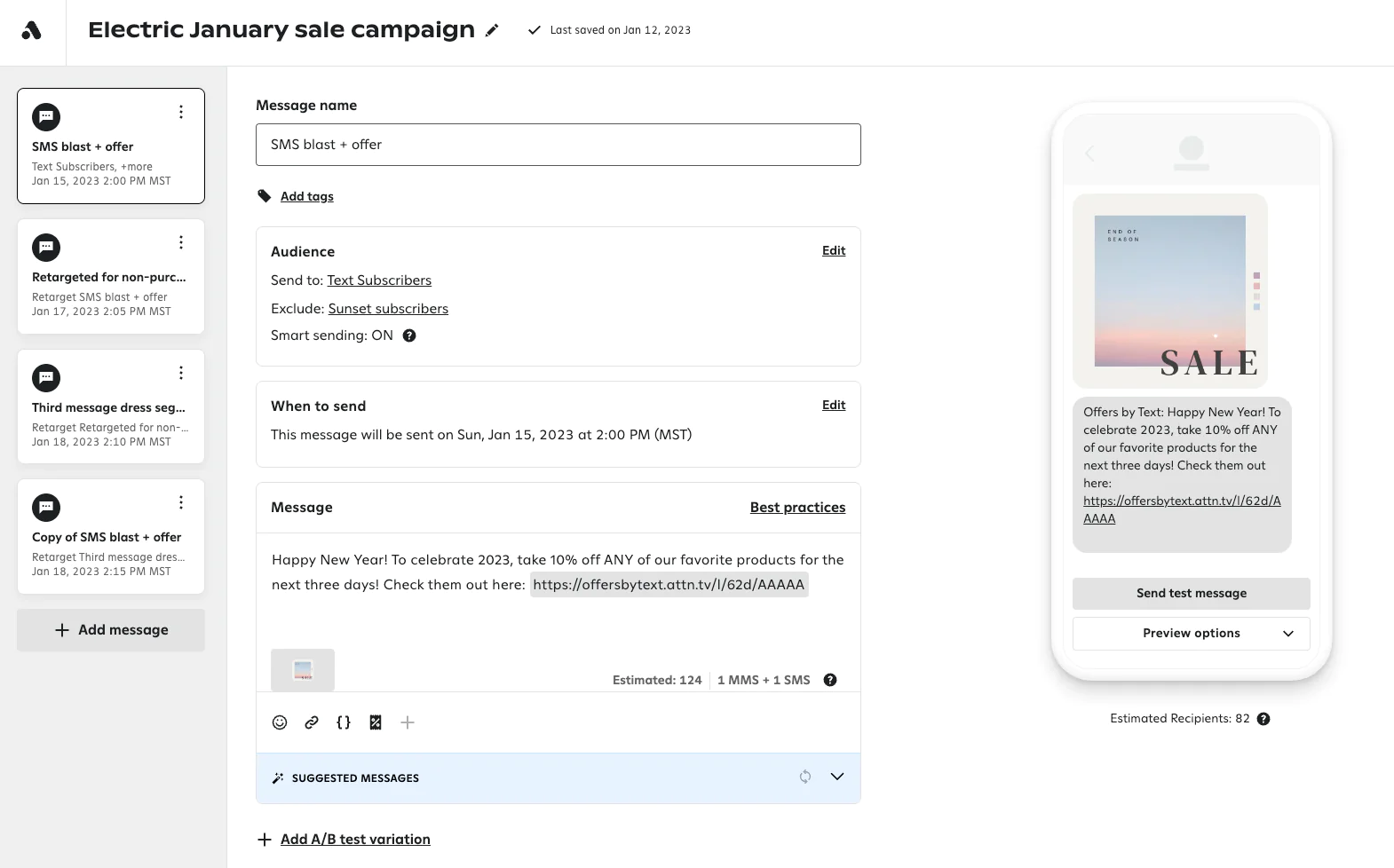
Attentive‘s Campaign Composer
It even supports two-way messaging via its “Concierge” feature, which uses AI (and in some cases human reps) to respond to customer texts in real time. This means your customers can actually reply to your promos—asking questions, getting recommendations—instead of receiving no-reply texts. It’s a conversational twist that helps brands engage customers like a real chat, not just a one-way megaphone.
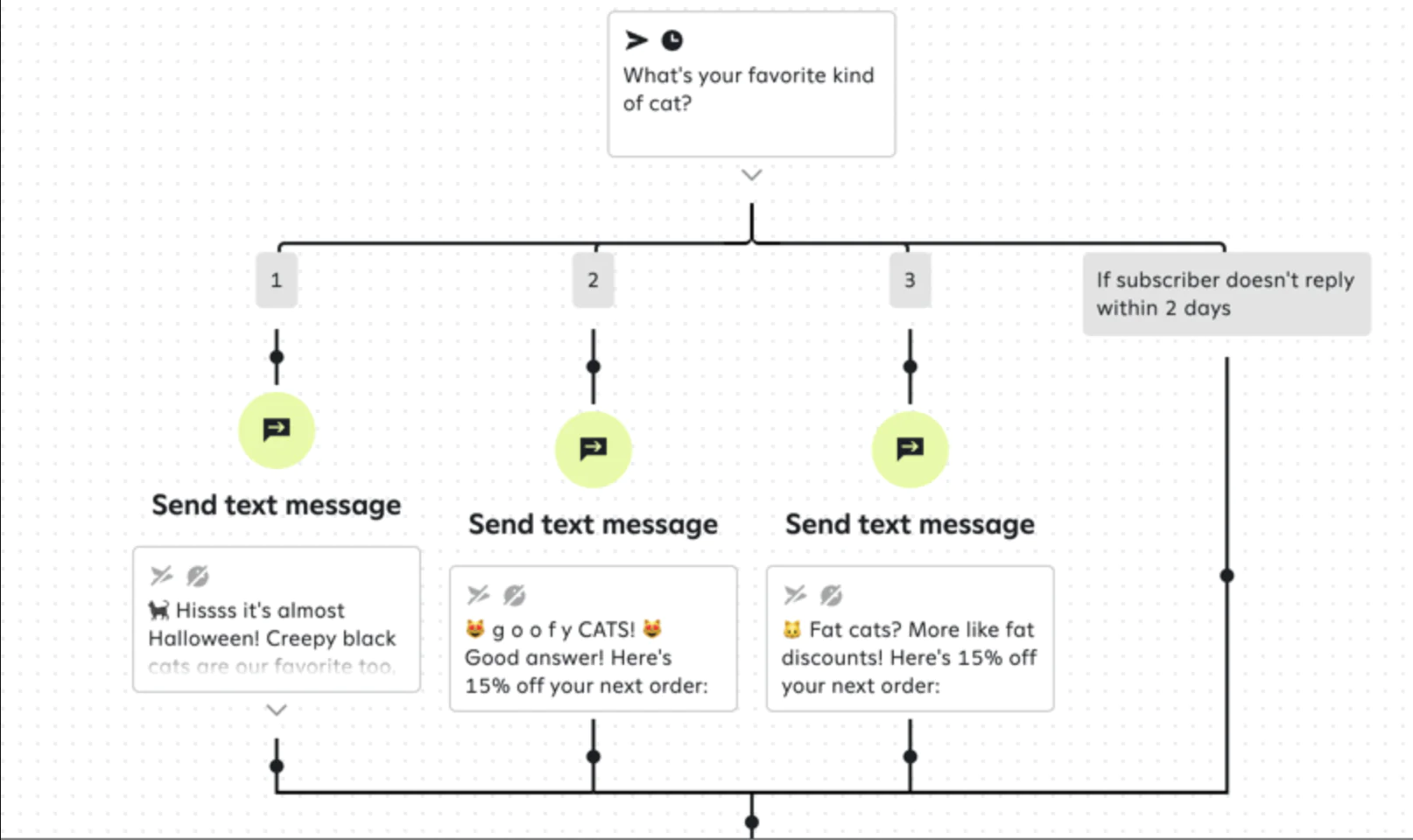
Two-way messaging in Attentive
Attentive also integrates with major e-commerce platforms (like Shopify and BigCommerce) so it can trigger texts based on customer actions (sign-ups, purchases, cart events) pretty seamlessly. It’s not reinventing the wheel on SMS, but it delivers what it promises: a robust text marketing channel that feels personal and direct.
Email marketing & list growth
While SMS is Attentive’s bread and butter, it hasn’t ignored email. After acquiring the email marketing tool Privy, Attentive added email campaign capabilities alongside its texting tools. The idea is to let brands manage email and SMS in one place.
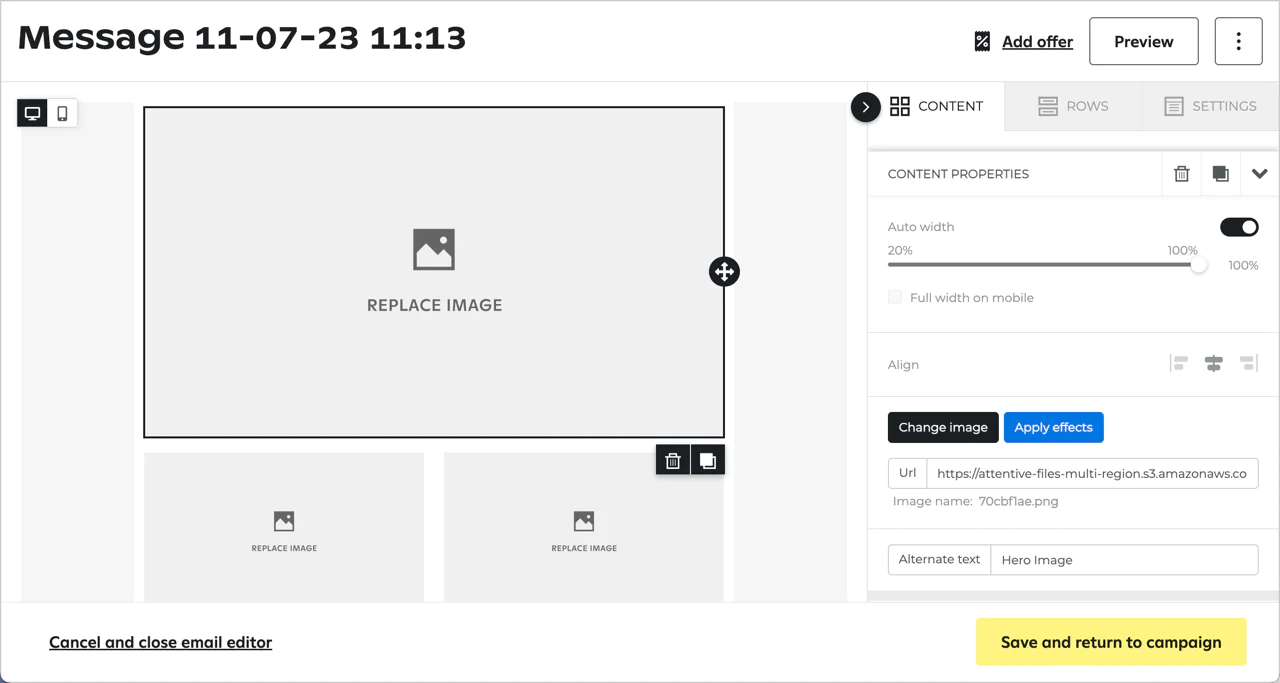
Attentive’s email builder
Attentive provides pop-ups and sign-up forms to grow your contact list (email addresses and phone numbers) on your site, then lets you send welcome emails or newsletters in addition to texts. The email functionality covers standard needs—you can design simple promotional emails, set up basic drip sequences, and track opens and clicks. It’s handy if you want a single platform for both email and SMS, especially for a quick start.
That said, Attentive’s email tools are relatively basic compared to dedicated email platforms. You won’t find the deep email template libraries or advanced deliverability optimization that an email-focused service might offer.
Still, for many Attentive clients, having a built-in email option is better than juggling a completely separate system. It’s a convenience play: capture subscribers once, then reach them via both inbox and text message as needed.
AI and analytics
Attentive has started to infuse more AI-driven features and analytics into its platform. Its Attentive AI aims to help marketers work smarter by suggesting optimal send times or even generating high-performing message copy for campaigns. In theory, that means quicker campaign creation—let AI draft a text and subject line, tweak as needed, and you’re good to go.
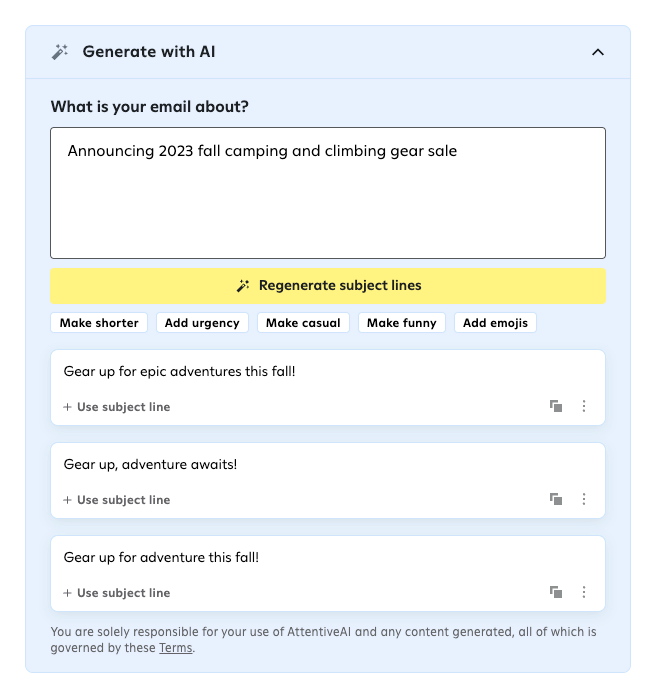
Creating email subject line with AI Assistant
Attentive also provides an analytics dashboard to review campaign performance. You can see how much revenue your SMS campaigns generate, track click-through rates, and measure subscriber growth over time. The reporting is clear and customizable, to a point—you can filter by segment or timeframe and create simple custom reports.
For most businesses, these metrics cover the essentials: you’ll know if your texts are driving sales or falling flat. However, if you’re looking to do very deep data dives or cross-channel attribution, Attentive might feel limiting. It focuses on the data in its own silo (texts and emails) and less on multi-touch journeys.
But overall, the AI suggestions and built-in stats do make it easier to optimize campaigns without exporting data to a separate BI tool. It’s all about making SMS (and email) marketing a bit more intelligent and efficient out-of-the-box.
Pain Points with Attentive
Cost
Attentive’s pricing can hit like a sucker punch. There’s no public price sheet with simple tiers—you often need a demo or quote, which is a hint that it’s not the cheapest option. Many small brands start with Attentive via a free trial or low monthly minimum, only to find costs ramp up quickly as their subscriber list and send volume grow.
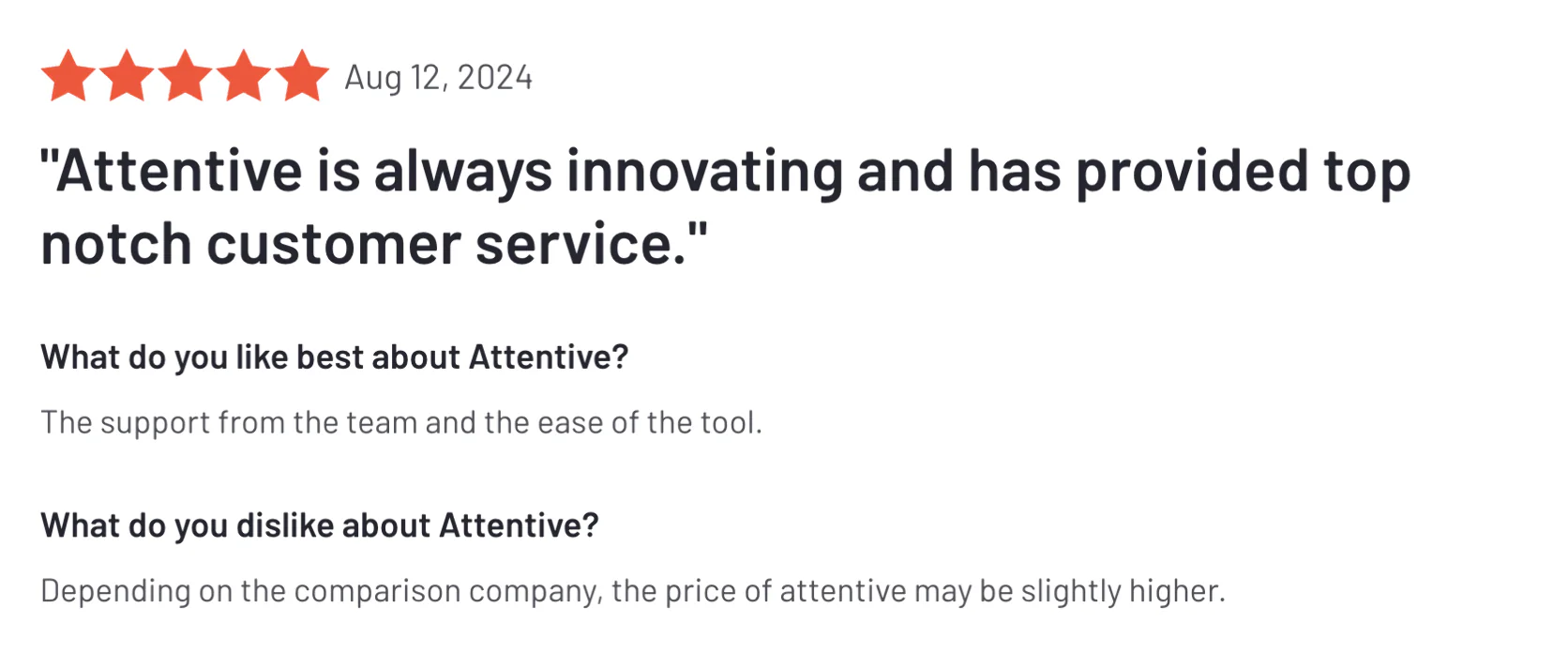
Attentive typically charges a base platform fee plus per-message fees, so success (i.e. more texts sent) ironically makes it more expensive. Imagine paying a few hundred dollars a month, plus cents on every SMS and MMS—it adds up fast. Want to send picture messages with your texts? Those MMS can cost more.
As you unlock features like two-way messaging or more advanced segmentation, you might be pushed into higher pricing tiers or enterprise plans. For small and mid-sized businesses, it’s hard to justify sticking with Attentive if the ROI isn’t keeping pace with the rising bill.
The lack of transparent pricing also means you could end up overpaying if you’re not actively negotiating or monitoring usage. In short, Attentive can deliver results, but you’ll pay a premium for the ride, and budgeting for it can feel like aiming at a moving target.
Limited channels and functionality
Attentive is laser-focused on texting (with a side of email), and that narrow focus can become a limitation. Modern brands want to engage customers on multiple channels—not just SMS and email, but also push notifications, in-app messages, WhatsApp, web pop-ups, and more. Attentive doesn’t natively support those additional channels.
If you need to send push notifications or craft on-site personalized content, you’re out of luck and shopping for yet another tool. This means your marketing stack can become a patchwork: Attentive for SMS, something else for push, another for on-site personalization, etc., with data siloed in each.
Attentive’s email capability helps a bit, but it still leaves out big pieces of the customer journey (e.g. no built-in web personalization or loyalty program features). Even within its comfort zone of SMS, some users crave more sophistication.

For example, Attentive’s segmentation is solid for messaging (filtering by purchase history or behavior), but creating highly dynamic, cross-channel customer journeys can be challenging. There’s no built-in customer data platform to unify all your touchpoints in real-time.
If you want to trigger an SMS based on a complex event (say, customer viewed product X three times this week AND hasn’t purchased in 30 days AND didn’t open last email), you might struggle or need an external system. In short, Attentive can start to feel like a one-trick pony. Great at SMS, okay at email, but beyond that, you’ll be cobbling together solutions.
Customer support and onboarding challenges
When you’re paying for a high-end platform like Attentive, you expect high-end support—but many users report that Attentive’s customer service doesn’t always rise to the occasion. If something goes wrong with a campaign or you hit a technical snag, you might find yourself waiting on support tickets longer than you’d like.
Sure, Attentive assigns account managers to larger clients, but smaller customers often rely on general support queues. The experience can be hit-or-miss: some get quick, helpful responses, while others encounter slow turnarounds or reps who simply reiterate help docs.
This can be frustrating, especially during onboarding when you’re trying to get up to speed with a new system. Implementing an SMS program involves a lot of moving parts—compliance setup, integration with your e-commerce store, designing campaigns—and delays in support can feel like roadblocks.
And let’s face it, when your revenue depends on timely messages (flash sales, holiday promotions, etc.), waiting days for an email back from support isn’t tenable. Attentive does provide resources and a help center, but the hands-on guidance can fall short unless you’re a large enterprise client.
The Alternatives at a Glance
With that in mind, let’s take a look at some of the popular alternatives.
Best For
Key Features
Price Range
Maestra
Full-funnel marketing for ambitious e-commerce brands
Full-funnel marketing for ambitious e-commerce brands
• Real-time CDP for behavior-driven segmentation
• Hyper-personalized omnichannel flows
• Built-in loyalty program and promotions engine
• Real-time site personalization
• Dedicated Customer Success Manager
• Hyper-personalized omnichannel flows
• Built-in loyalty program and promotions engine
• Real-time site personalization
• Dedicated Customer Success Manager
From $2,990/month
Klaviyo
Integrated email & SMS automation for data-driven marketers
Integrated email & SMS automation for data-driven marketers
• Powerful segmentation with e-commerce data
• Pre-built email and SMS flow templates
• 300 integrations (Shopify, Magento, etc.)
• Dynamic personalization and A/B testing
• Pre-built email and SMS flow templates
• 300 integrations (Shopify, Magento, etc.)
• Dynamic personalization and A/B testing
Free tier; Paid plans from ~$20/month (plus usage)
Postscript
Shopify-centric SMS campaigns for online stores
Shopify-centric SMS campaigns for online stores
• Seamless Shopify integration for SMS
• Easy opt-in tools (pop-ups, keywords) for list growth
• Automated cart abandonment and product back-in-stock texts
• Simple, usage-based pricing model
• Easy opt-in tools (pop-ups, keywords) for list growth
• Automated cart abandonment and product back-in-stock texts
• Simple, usage-based pricing model
Starter free, then from ~$25/month (usage-based)
Braze
Enterprise-grade omnichannel customer engagement
Enterprise-grade omnichannel customer engagement
• Multi-channel campaigns (SMS, push, email, in-app) at scale
• Real-time data streaming & segmentation
• Advanced personalization with dynamic content
• Robust analytics and journey orchestration tools
• Real-time data streaming & segmentation
• Advanced personalization with dynamic content
• Robust analytics and journey orchestration tools
Custom pricing (enterprise)
Omnisend
All-in-one email, SMS, & push for SMB e-commerce
All-in-one email, SMS, & push for SMB e-commerce
• Pre-built automation workflows (welcome series, cart recovery)
• Drag-and-drop campaign builder
• Email, SMS, and web push from one platform
• Deep Shopify and WooCommerce integration
• Drag-and-drop campaign builder
• Email, SMS, and web push from one platform
• Deep Shopify and WooCommerce integration
Free plan; Paid plans from ~$16/month
Emotive
Two-way conversational SMS marketing with a human touch
Two-way conversational SMS marketing with a human touch
• 1:1 text conversations at scale (real human agents + AI)
• AI assistance to triage and respond to customer texts
• Interactive campaigns (quizzes, two-way promos)
• Revenue-focused analytics and ROI dashboard
• AI assistance to triage and respond to customer texts
• Interactive campaigns (quizzes, two-way promos)
• Revenue-focused analytics and ROI dashboard
Custom pricing (offers to beat competitors; ~$100+/month based on usage)
SimpleTexting
Straightforward text message marketing for any business
Straightforward text message marketing for any business
• Easy mass texting with no coding
• MMS support for images and multimedia texts
• Keywords and auto-replies for customer interaction
• Contact management and scheduling tools
• MMS support for images and multimedia texts
• Keywords and auto-replies for customer interaction
• Contact management and scheduling tools
From $29/month (includes a set number of messages)
Twilio
Developer-friendly SMS API for custom solutions
Developer-friendly SMS API for custom solutions
• API access for SMS, MMS, WhatsApp, and more
• Highly scalable and reliable infrastructure
• Allows full customization of messaging workflows
• Extensive documentation and developer tools
• Highly scalable and reliable infrastructure
• Allows full customization of messaging workflows
• Extensive documentation and developer tools
Pay-as-you-go (≈$0.0075 per SMS + minimal monthly fees)
OneSignal
Push notification leader expanding into multi-channel messaging
Push notification leader expanding into multi-channel messaging
• Mobile and web push notifications at its core
• In-app messaging and email capabilities added
• Segmentation based on user behavior and device
• Developer-friendly SDKs for easy integration
• In-app messaging and email capabilities added
• Segmentation based on user behavior and device
• Developer-friendly SDKs for easy integration
Free tier; Paid plans from $9/month
Now let’s dive into detailed reviews of each alternative, how they stack up, and how they compare to both Attentive and Maestra.
Tool #1: Maestra
Best Attentive alternative for comprehensive omnichannel marketing
Maestra is an all-in-one omnichannel marketing platform built for e-commerce brands ready to leave the patchwork approach behind. With integrated email, SMS, push notifications, loyalty programs, and on-site personalization, Maestra doesn’t just help you keep up—it helps you leap ahead.
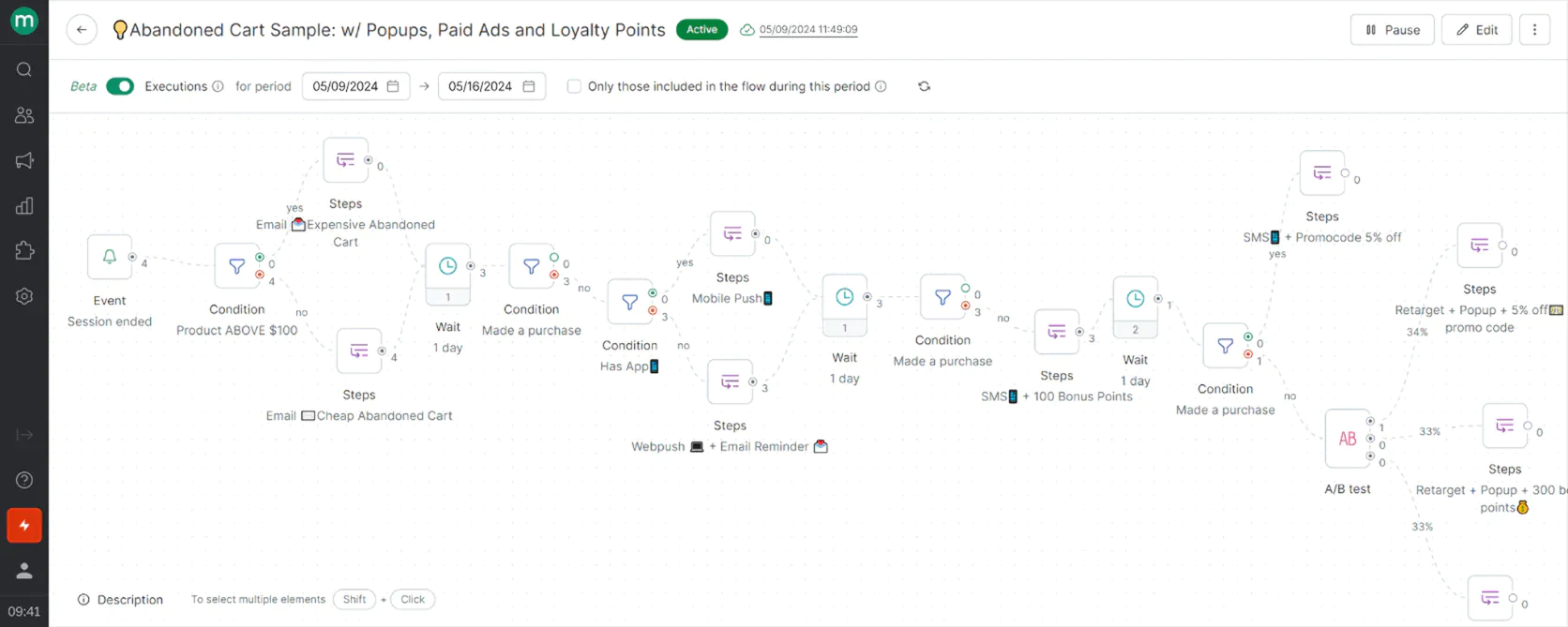
Maestra’s flow example: abandoned card flow with emails, mobile and web pushes, pop-ups, paid ads and loyalty points
The platform centers on a real-time customer data platform (CDP), which means every customer action (a click, a browse, a purchase) can instantly trigger tailored marketing across any channel. Out of the box, Maestra provides advanced segmentation and a drag-and-drop journey builder so you can design flows that reach customers at the perfect moment on the perfect channel.
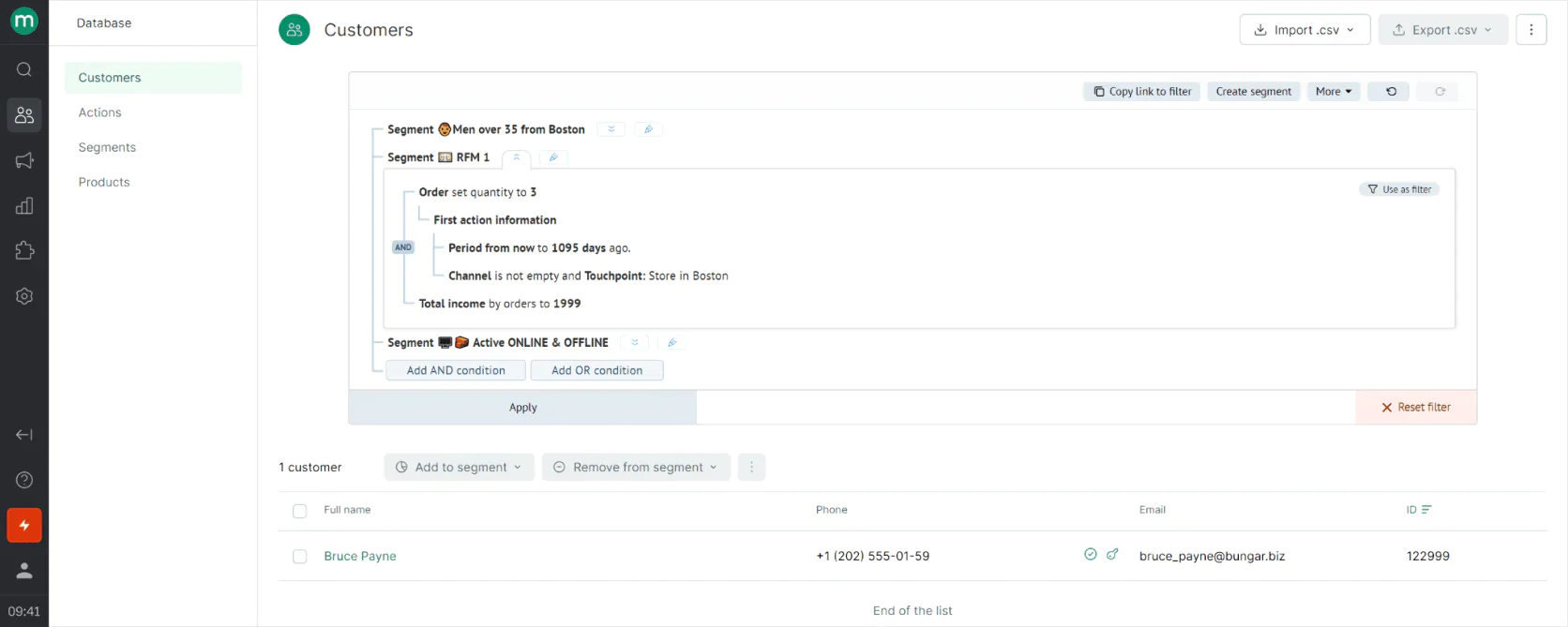
Maestra’s segment builder
Think email + SMS combos, follow-up texts that sync with what someone did on your site, and even personalized product recommendations on your homepage—all coordinated within one system. Maestra’s philosophy is to replace a tangle of single-purpose tools with one unified hub for customer engagement.
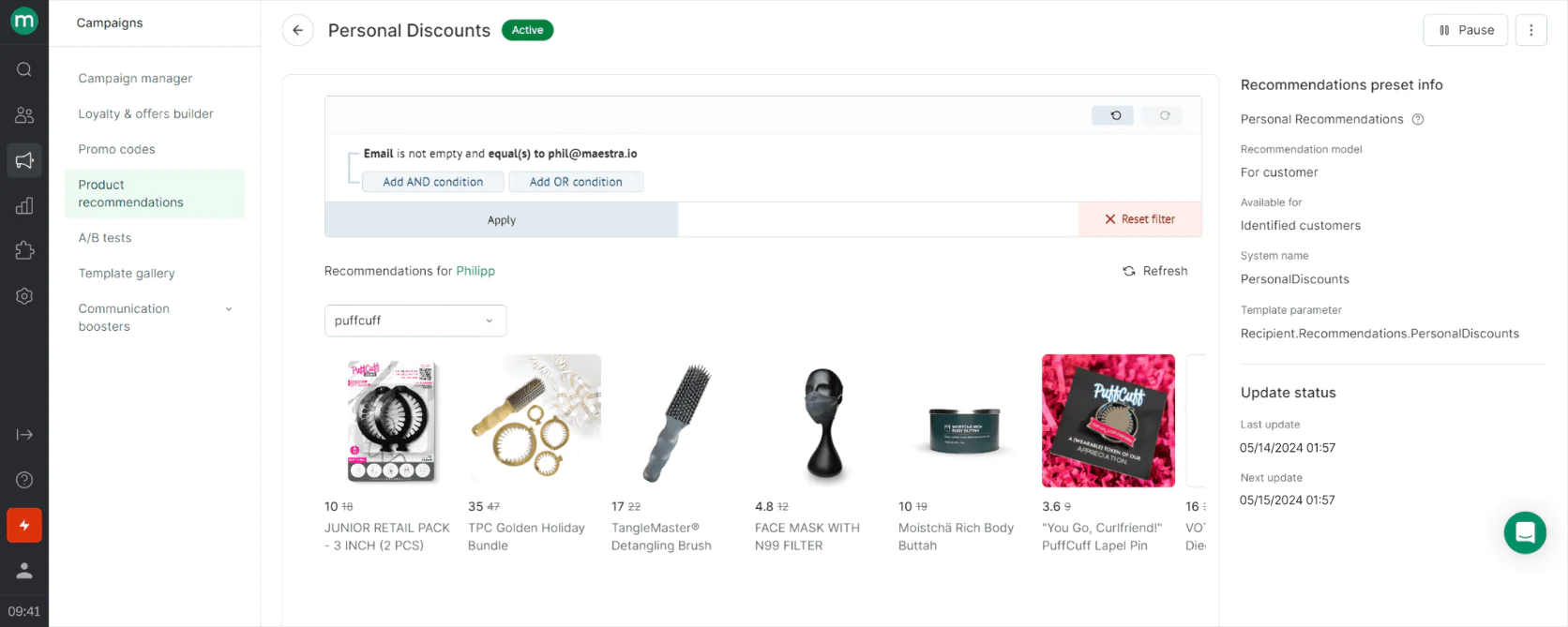
Maestra: сreating a personalized recommendations block
Instead of juggling separate apps for loyalty, email, SMS, etc., you get one platform where all these capabilities work in concert. It’s like having a marketing command center that gives you a 360° view of the customer and the controls to engage them with precision.
Key Features:
- Unified Omnichannel Automation streamlines campaign management across email, SMS, web, and mobile from one central dashboard. Design intricate customer journeys that adapt to real-time actions, ensuring the right message reaches the best channel at the ideal time.
- Advanced Customer Data Platform integrates online and offline data, allowing detailed segmentation down to specific interactions. This drives highly personalized experiences rooted in a comprehensive view of each customer.
- Integrated Loyalty & Referral Programs remove the need for standalone tools. Offer rewards like points, VIP levels, and referral bonuses—all seamlessly handled within the same platform as your messaging.
- Dynamic Website Personalization tailors unique experiences for every visitor. Welcome back returning customers by name, highlight products based on their browsing habits, and deliver AI-powered, targeted offers.
- Intelligent Promotions Engine simplifies discount handling with automated delivery, redemption monitoring, and expiration controls, precisely aligned with your chosen segments.
- White-Glove Support provides each client with a dedicated Customer Success Manager to assist with onboarding, strategy, and technical setup—delivering top-tier service uncommon at this price level.
Strengths and weaknesses
Maestra’s biggest strength? Making every customer interaction feel personal, at scale. It’s not about just hitting “send”—it’s about hitting the mark every time. With its drag-and-drop flow builder and unified data, you can create hyper-targeted campaigns that seamlessly weave across email, SMS, your website, and even ad platforms.
For example, you could set up a flow where a customer who browses a product gets an in-app pop-up offering a discount, then an hour later an SMS if they didn’t purchase, and a day later an email with a related product recommendation—all without manual intervention. This kind of orchestration is where Maestra shines.

The level of real-time responsiveness is impressive: you can trigger messages on micro-events like “customer viewed X but didn’t add to cart” or “VIP customer just hit 100 loyalty points,” capitalizing on moments that generic tools would miss. Another strength is Maestra’s attention to detail in execution.
Emails are optimized to avoid the dreaded Gmail clipping (so your long, image-heavy newsletters still land perfectly). SMS messages can include dynamic shortening and fallbacks to ensure compliance and deliverability. Everything is geared toward maximizing impact—the right channel, right content, right time.
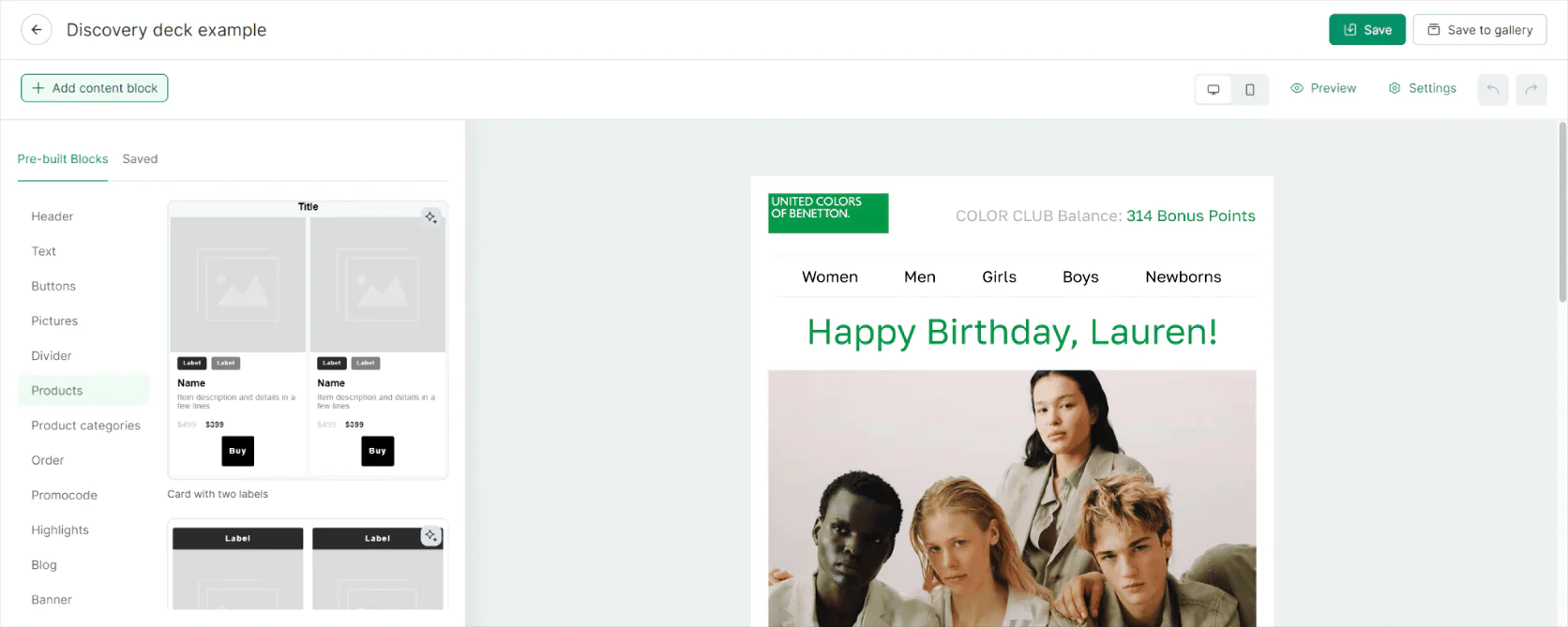
Maestra’s visual email composer
When it comes to drawbacks, Maestra doesn’t give you much to gripe about on features—it’s a very comprehensive platform—but there are two considerations. First, the pricing starts at $2,990 per month. There’s no free plan, and that price could be a hurdle for smaller businesses. However, the cost reflects the value and breadth; it’s not just software, it’s effectively software + service, given the included support and setup help.
Second, Maestra currently doesn’t include a built-in user-generated content (UGC) management tool (for curating and displaying customer photos/reviews). It excels at incentivizing reviews and leveraging social proof in campaigns (like emailing a discount when someone submits a review), but if you need a gallery of shoppable Instagram photos on your site, you’d integrate a UGC tool for that.
In short, Maestra’s weaknesses are less about what it does poorly and more about what it chooses not to focus on (UGC curation) or the fact that it’s built for brands ready to invest in a top-tier solution.
Compared to Attentive
Attentive is a specialist—it’s great at SMS marketing and has added email—but it remains relatively siloed and limited in scope. If Attentive is a powerful solo instrument, Maestra is the full orchestra. Compared to Attentive, Maestra offers a far broader range of channels and capabilities under one roof.
Attentive users might appreciate its focus and ease for texting, but they often need to bolt on other tools for email (if Attentive’s isn’t enough), for push notifications, or for loyalty programs. Maestra eliminates that need by providing a truly omnichannel solution.
Also, Attentive’s reliance on batch data updates and third-party integrations can leave marketers juggling spreadsheets or waiting for systems to sync. In contrast, Maestra’s real-time CDP means your campaigns can react instantly to customer behavior (Attentive, for example, can’t easily pause an email send if a customer makes a purchase on another channel in real time—Maestra can).
Attentive does offer two-way SMS and good segmentation for texts, but Maestra matches those SMS capabilities and raises the stakes with its cross-channel intelligence. In summary, Attentive might feel like a one-way conversation in a single channel, whereas Maestra is a dynamic conversation with the customer across all touchpoints.
Brands looking to move beyond Attentive’s SMS-first approach will find Maestra’s breadth and depth a game-changer.
Tool #2: Klaviyo
Best Attentive alternative for integrated email and SMS marketing
Klaviyo is a well-known marketing automation platform tailored for e-commerce, and it has made a name for itself by combining email and SMS in one powerful package. If you’ve been relying on Attentive for texts and another tool for email, Klaviyo’s appeal is clear: it brings those channels (and your customer data) together under one roof.
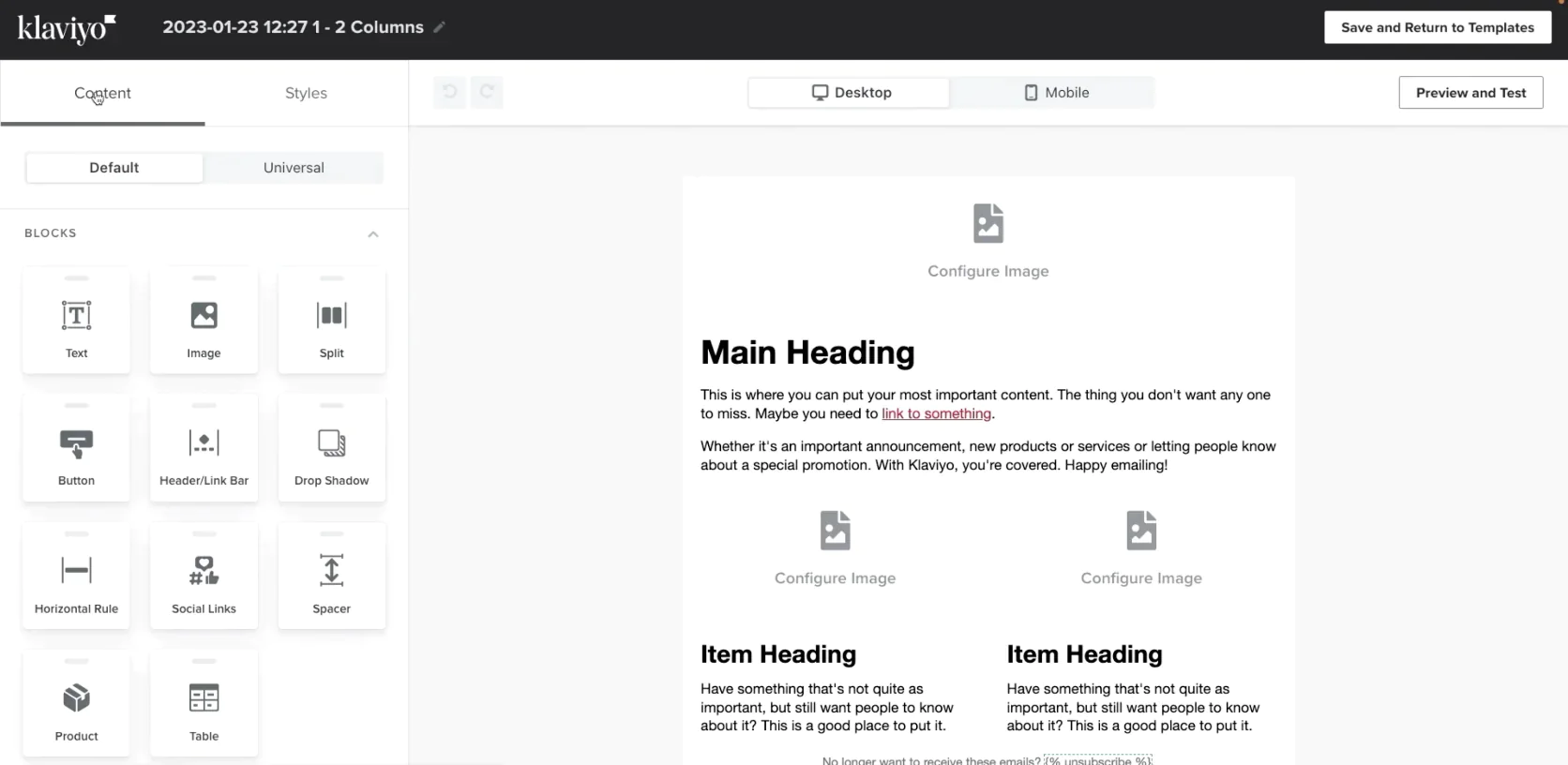
Klaviyo’s email composer
With Klaviyo, you can build detailed customer segments using e-commerce data (like shopping behavior, purchase history, website activity) and then target those segments with both email campaigns and text messages. The platform offers a rich set of pre-built automation flows—for example, abandoned cart series, welcome series, post-purchase follow-ups—that cover both email and SMS steps.

Klaviyo’s segment builder
This means a newcomer can quickly get sophisticated multi-step campaigns up and running without heavy lifting. Klaviyo’s deep integration with e-commerce platforms (Shopify, Magento, BigCommerce, etc.) allows it to pull in product data, purchase events, and even predictive analytics (like expected customer lifetime value or churn risk), which you can use to tailor your messaging.
Essentially, Klaviyo acts as a brain that centralizes customer insights and orchestrates personalized communication, rather than having email and SMS operate in separate silos.
Key Features:
- Unified customer profiles: Combines email & SMS engagement data with purchase history for each contact.
- Powerful segmentation: Create segments on virtually any behavior (e.g., “Bought at least $500 AND clicked last campaign AND hasn’t purchased in 90 days”).
- Email + SMS flows: Drag-and-drop visual flow builder to mix email and text steps in one automation (great for things like abandoned cart or birthday campaigns).
- Templates and content blocks: Extensive library of email templates and an SMS content editor with link tracking, personalization, and compliance tools (easy opt-out management, etc.).
- Integrations: 300+ integrations including e-commerce, helpdesks, review apps, and ad platforms—Klaviyo plays nicely with the rest of your stack.
- Reporting & attribution: Dashboard to see revenue attributed to email vs SMS, engagement over time, and even predictive metrics for customer lifetime value.
- APIs and customization: For developers, Klaviyo offers APIs to push custom events or pull data out, allowing more complex use-cases if needed.
Strengths and weaknesses
One of Klaviyo’s biggest strengths is its deep roots in e-commerce data. It was built for online stores, so it naturally speaks the language of catalogs, orders, and customer lifecycle. This translates into really useful capabilities—for instance, you can easily set up a “win-back” flow targeting customers who bought a particular product category but haven’t returned in X days, or send a price-drop alert email/SMS when an item someone viewed goes on sale.
The platform’s ease of use is frequently praised: marketers (even those without coding skills) can navigate the interface, create segments, and design emails with a straightforward drag-and-drop editor. Adding SMS in recent years has been a game changer; you manage text and email in the same flow, ensuring customers get a cohesive experience (not a random barrage).
Klaviyo also has a strong community and knowledge base—because it’s widely used, there are plenty of guides, best practices, and even pre-built recipes for campaigns. Another strength is deliverability and optimization. Klaviyo helps manage email deliverability (through tools like customizable sending domains and automatic suppressions for unengaged contacts) so your emails actually hit inboxes, and its reporting helps you fine-tune timing and content for max engagement.
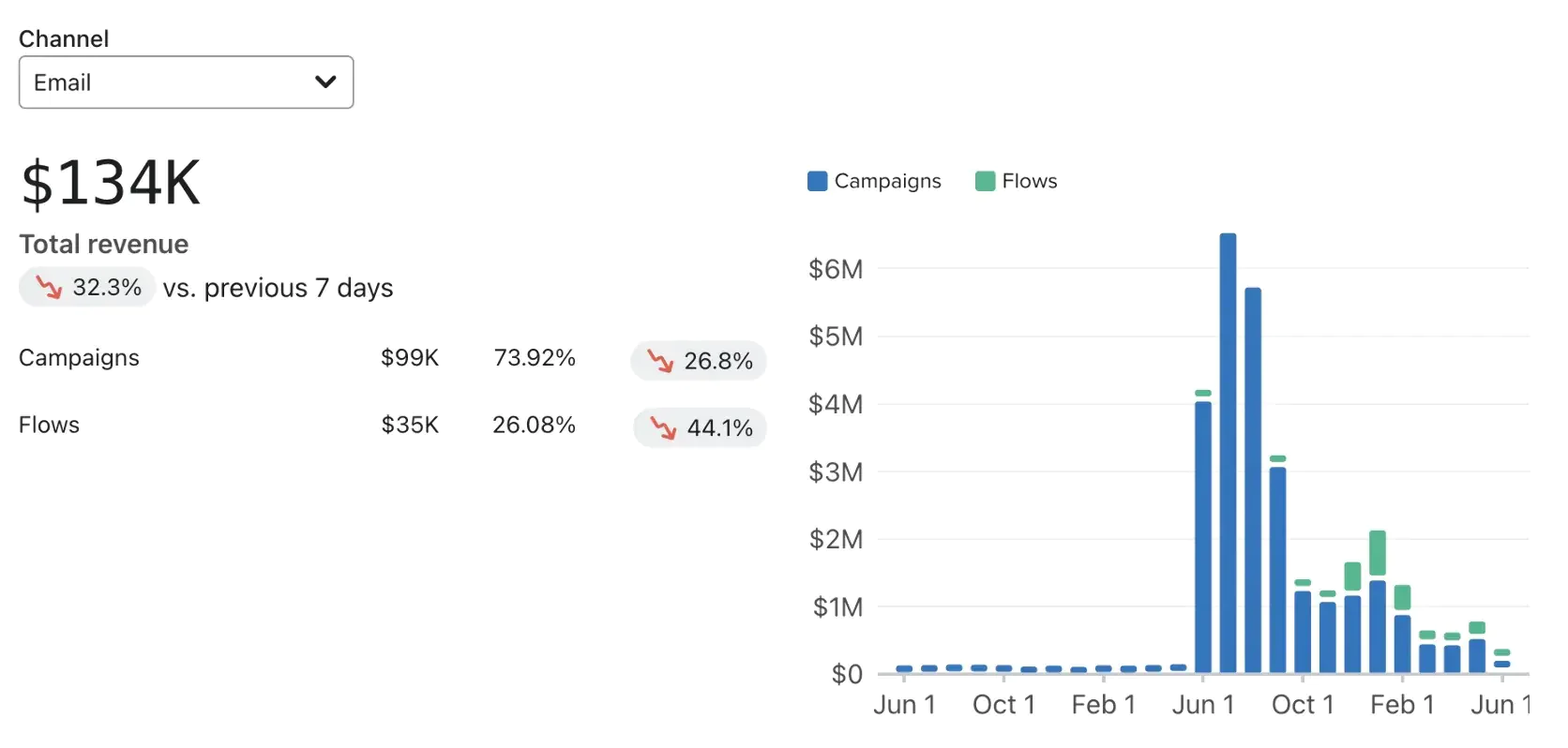
Fragment of Klaviyo’s business review dashboard
On the downside, Klaviyo can become expensive as your contact list grows, especially since you’re often paying for email contacts and SMS messages in one platform. A rapidly scaling brand might see their Klaviyo bill climb quickly into the hundreds or thousands per month (though Attentive isn’t cheap either, Klaviyo’s pricing is very contact-count dependent).
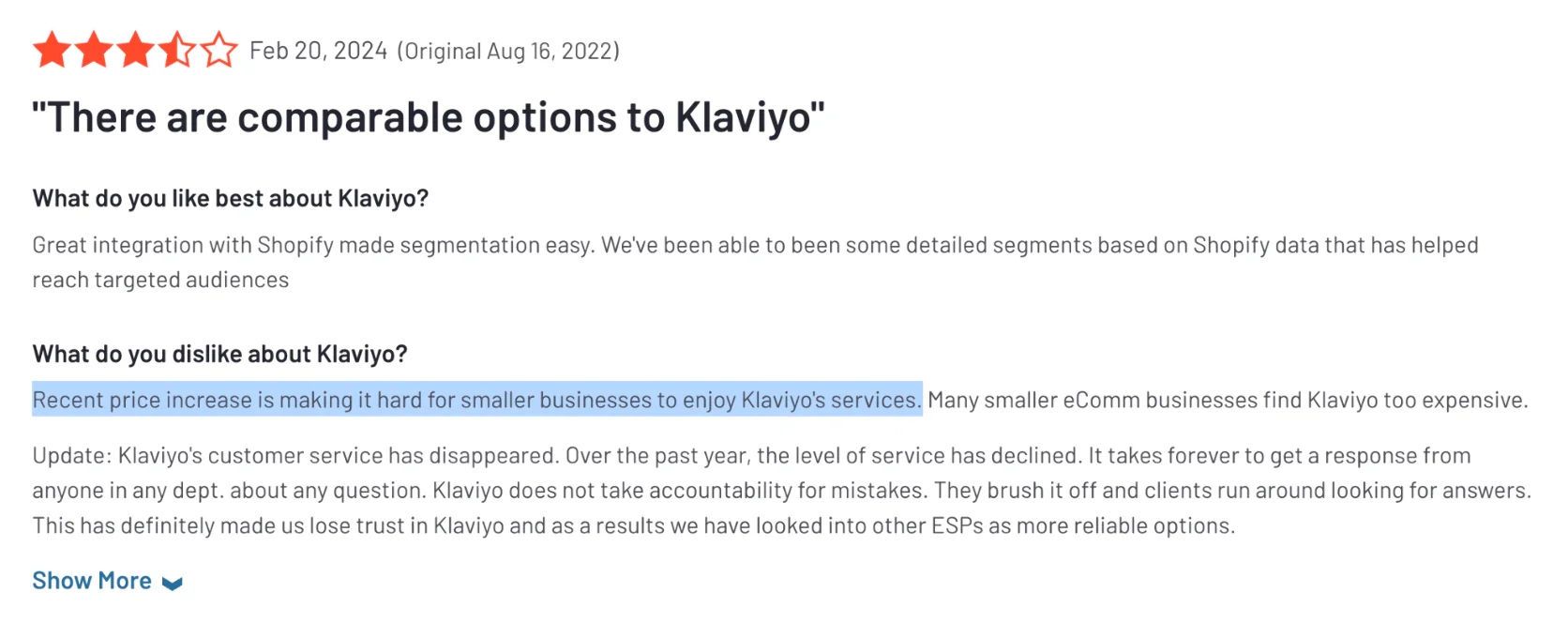
Also, while Klaviyo is great at email and SMS, it doesn’t natively support channels like push notifications or in-app messages—it sticks to what it does best. So, it’s more multi-channel than Attentive (having email+SMS), but not omnichannel in the way some larger platforms (or Maestra) are.
Another consideration: learning curve for advanced features. Basic stuff is easy, but Klaviyo is very robust, and truly mastering its segmentation logic or fully exploiting its personalization (like building complex dynamic blocks in emails) takes some time and skill.
Lastly, some users report that Klaviyo’s email builder, while good, isn’t the most modern or slick compared to newer email tools—it’s functional but can feel a bit dated in UI. These are relatively minor issues in the grand scheme, but they’re worth noting for a balanced view.
Compared to Attentive
Klaviyo and Attentive have been on a bit of a collision course, each encroaching on the other’s territory: Attentive added email to complement its SMS, and Klaviyo added SMS to complement its email. The difference is Klaviyo started on the email/data side, and it shows.
Compared to Attentive, Klaviyo offers more sophisticated data integration and segmentation capabilities. For example, Attentive might let you segment by whether someone clicked a text or not, but Klaviyo can create a segment like “VIP customers in California who purchased in the last 30 days and clicked any message about ‘Shoes’.” It’s that granular.
Klaviyo’s email features are also far more mature than Attentive’s nascent email tool—things like advanced email A/B testing, automated resending to unopens, or intricate template designs are Klaviyo’s bread and butter, whereas Attentive’s email is pretty bare-bones.
In terms of SMS capabilities, Attentive might have a slight edge on some SMS-specific innovations (they’ve been focused on SMS longer, so features like their two-way Concierge or certain compliance guardrails are very polished). But Klaviyo’s SMS is no slouch—it covers essentials like two-way messaging, segmentation, and automated flows, all integrated with email.
Attentive tends to position itself as more high-touch (they might manage more of the campaign creation for you via their team, acting almost as an extension of your team), whereas Klaviyo is very self-serve.
If you value control and depth of data, Klaviyo is likely more appealing than Attentive. On the other hand, if you wanted a hands-off approach with a vendor curating a lot of your SMS strategy, Attentive might pitch that (though at a cost).
Ultimately, many brands choose Klaviyo over Attentive because they want one platform for both email and SMS, and they trust Klaviyo’s robustness for email. It often comes down to this: Attentive can be great solely for SMS, but if you need a true multi-channel CRM with strong analytics, Klaviyo is a more complete package.
Compared to Maestra
Klaviyo vs. Maestra is a classic case of a point solution versus a platform. Klaviyo is excellent for email and SMS automation. But Maestra takes things a step further by incorporating channels and features Klaviyo doesn’t.
For instance, Maestra has built-in loyalty and rewards capabilities, on-site personalization, and push notifications, none of which Klaviyo offers natively. So with Klaviyo, you might still need additional tools for loyalty programs or website personalization (and then try to integrate them), whereas Maestra includes those in one system.
Also, Maestra’s real-time CDP means it’s aggregating data from every touchpoint instantly. Klaviyo has a strong data foundation with e-com events, but it might not capture, say, real-time web behavior for on-site personalization on the fly—Maestra does.
Another difference is the level of strategic service: Klaviyo is mostly a do-it-yourself platform (with support available, and agency partners if you need), while Maestra bundles in strategy and support via a dedicated CSM as mentioned. That means Maestra often feels like a more white-glove, enterprise solution, whereas Klaviyo is more DIY.
If email+SMS covers 99% of your needs and you have the team to run it, Klaviyo could be sufficient. But if you want to unify more channels (and possibly have less internal bandwidth to manage everything solo), Maestra offers a broader canvas and hands-on help.
In many cases, brands outgrow Klaviyo when they start needing capabilities it doesn’t have—that’s where Maestra often comes into play, as an upgrade that consolidates what Klaviyo does and adds more on top.
Tool #3: Postscript
Best Attentive alternative for Shopify-centric SMS campaigns
Postscript is a popular SMS marketing platform specifically built for Shopify stores. If Attentive is a generalist across many industries, Postscript is a specialist: it zeroes in on e-commerce merchants (especially those on Shopify) who want to drive sales through text messaging.
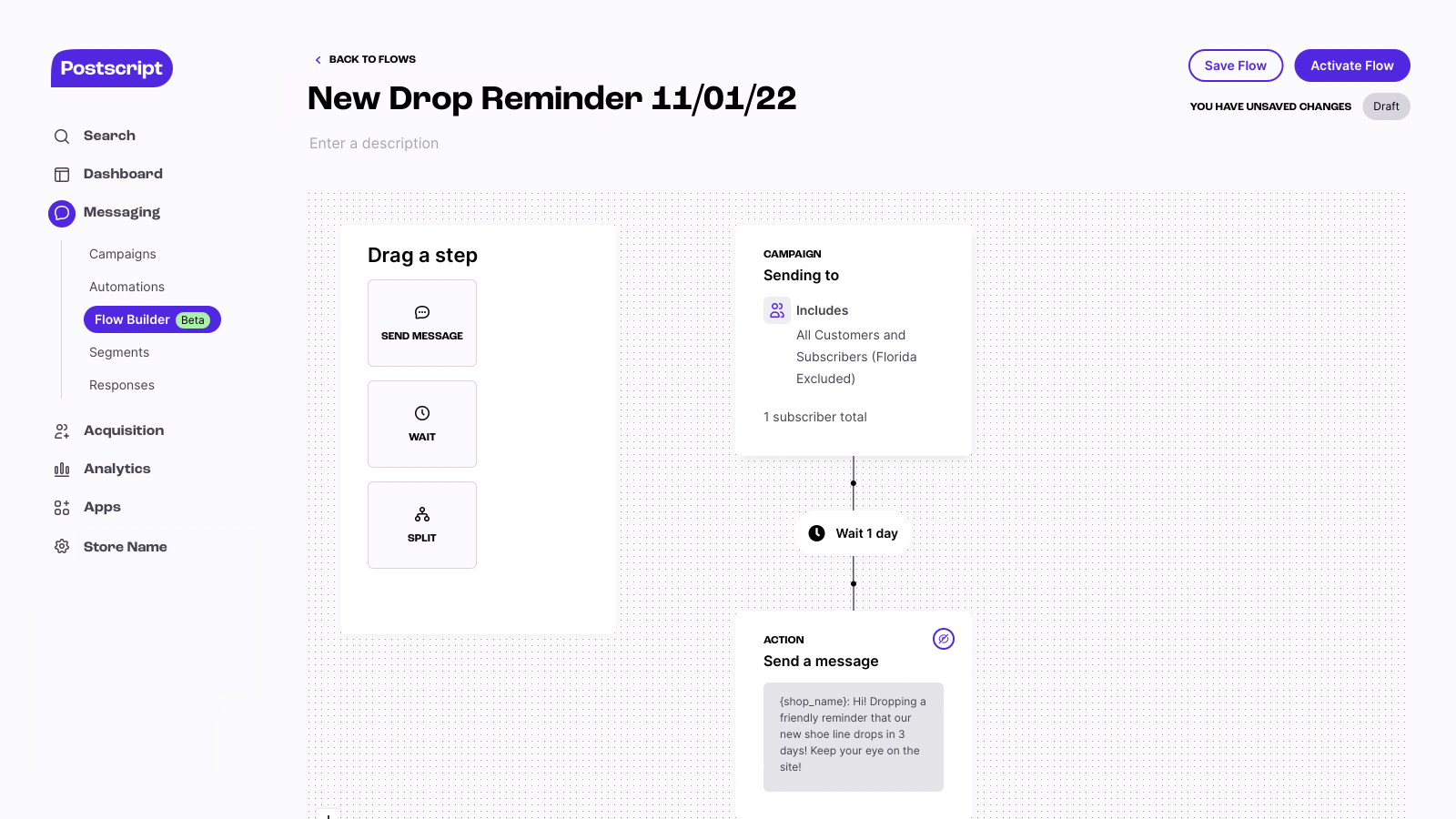
Postscript’s flow builder
The platform integrates deeply with Shopify, which means it can pull product data, customer tags, and order history seamlessly into your SMS campaigns. Setting up Postscript is as easy as installing a Shopify app—once connected, you get access to a suite of SMS tools tailored for online retail, like cart abandonment texts, shipping notification texts, and welcome offers for new subscribers.
One standout aspect is Postscript’s focus on compliance and opt-in collection in the Shopify environment. It provides plug-and-play opt-in widgets, pop-ups, and keywords that let customers subscribe to texts during checkout or via landing pages, ensuring your list grows in a compliant way.
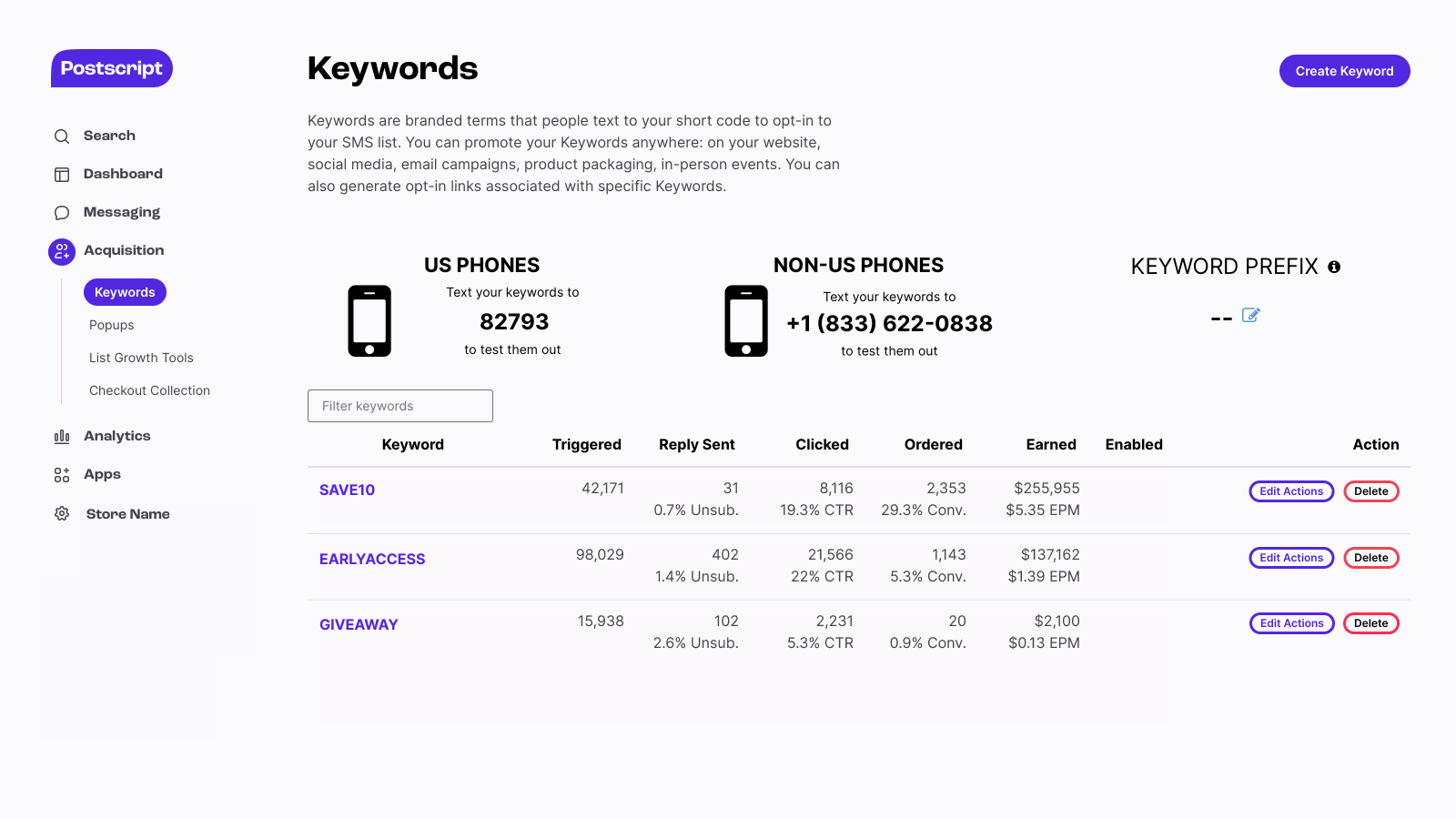
Postscript’s keyword opt-in
In terms of user experience, Postscript’s dashboard is straightforward: you can craft one-off campaigns or multi-step automated flows, use segmentation filters (like purchase behavior or Shopify customer tags), and see revenue attribution for your texts. It’s not overloaded with extraneous features—it sticks to what an e-com marketer needs to run a successful SMS program.
Key Features:
- Seamless Shopify integration: Syncs customer data, order history, and product info in real-time. You can insert product recommendations or dynamic discount codes into texts easily.
- Automated SMS flows: Built-in flows for things like abandoned cart, welcome series, and win-back campaigns.
- List growth tools: Native mobile number capture via pop-ups, checkout, and keyword campaigns.
- Two-way messaging: Customers can reply, and you can manage replies in a conversational inbox.
- Segmentation: Filter by total spend, items purchased, last purchase date, and more.
- MMS support and GIF library: Send engaging images or GIFs with built-in creative assets.
- Analytics & attribution: Track SMS-driven revenue, CTRs, and subscriber growth.
- Flexible pricing: Usage-based message credits—scale as you grow.
Strengths and weaknesses
Postscript’s strength lies in its simplicity and focus. For a Shopify merchant, it covers all the SMS essentials without a lot of fuss. Users often praise how quick it is to get started—you can install it and start texting your customers in the same afternoon.
The templates and pre-built flows mean you don’t have to brainstorm every message from scratch; Postscript gives you a starting point (like a series of 3 abandoned cart texts spaced out over a day or two) which you can tweak to your brand voice.

Creating an automation in Postscript
Another strong point is Postscript’s compliance safeguards. SMS marketing has strict legal requirements (TCPA, etc.), and Postscript helps by handling things like unsubscribe keywords automatically and providing compliant language for opt-ins. This is critical and something you don’t want to mess up.
In terms of performance, because it’s focused on e-commerce, all the features (segmentation, timing, etc.) are geared toward driving sales—and many brands see a nice revenue lift from using it. The platform also tends to be more affordable for SMBs compared to enterprise tools: you pay for the messages you send, starting at a reasonable base, so you can scale up without huge contracts.
On the flip side, Postscript is SMS-only (no email, no push, etc.), so it’s not a one-stop shop if you need multi-channel. Many Postscript users pair it with an email platform like Klaviyo (in fact, Postscript integrates with Klaviyo to sync data between the two). This means you could end up using multiple tools, whereas an Attentive or others might handle both channels together.
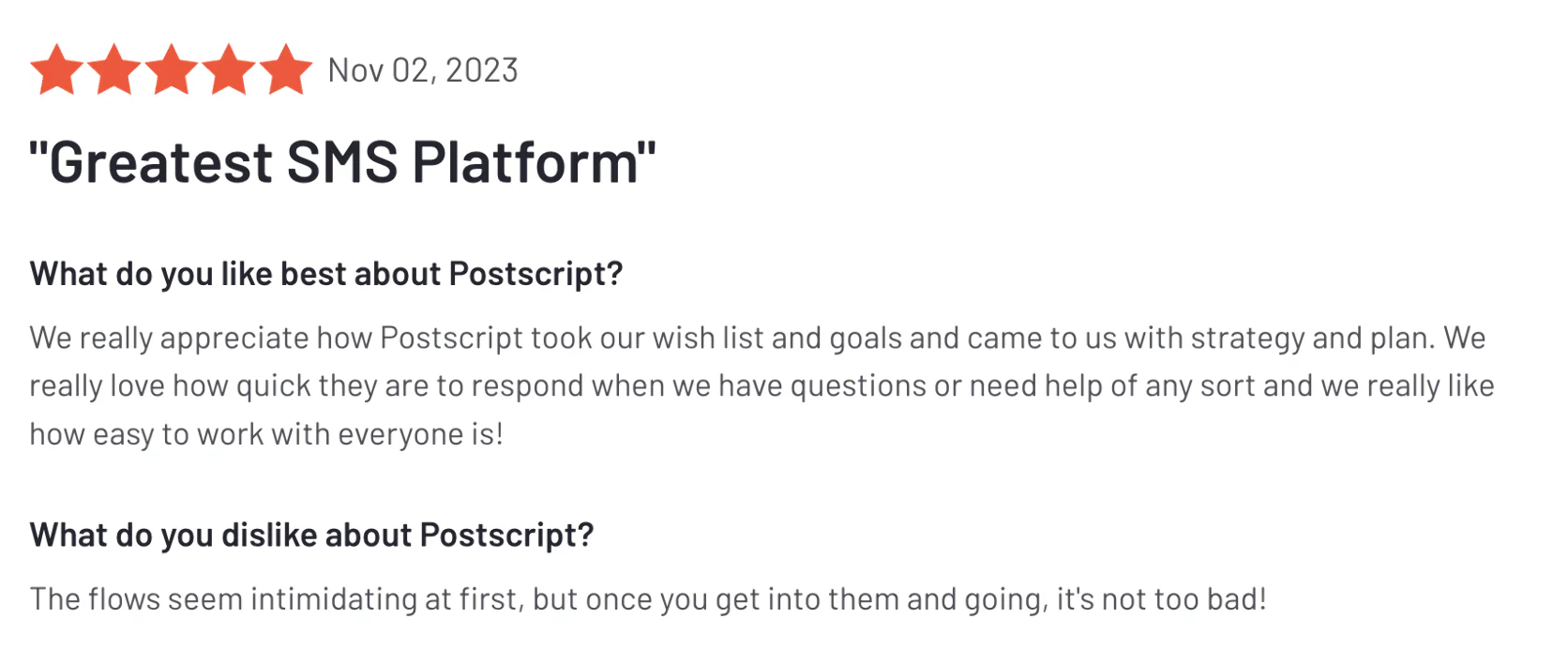
Another weakness is that Postscript’s feature set is narrower than a big platform’s—it doesn’t have advanced AI optimization or extremely granular segmentation logic that some larger systems offer. Its segmentation, while solid, is tied to the data Shopify provides.
For most smaller brands that’s fine, but larger ones might want to combine data from other sources (like in-store purchases or a loyalty program) which would be harder to do directly in Postscript. Also, the design capabilities for messages are limited by the nature of SMS/MMS—you can’t do fancy templates beyond adding an image or GIF.
So, you rely on concise, punchy text copy for impact. Lastly, because Postscript is very focused on Shopify, if you ever migrate off Shopify to another platform, you might have to switch SMS providers (though they have beta integrations for other platforms, Shopify is their home turf).
Compared to Attentive
For a brand on Shopify considering Attentive vs Postscript, a few distinctions stand out. Attentive is aiming to be more of an upscale, full-service solution—they often pair you with their own team for strategy, and they tout larger enterprise clients. Postscript is more self-service and SMB-friendly.
If you’re a smaller operation or just starting with SMS, Postscript’s simplicity is a plus. Attentive might wow you with AI features or promises of big lifts, but it also comes with higher cost and potentially a longer onboarding. Postscript can often get you similar core results (recovering abandoned carts via text, sending promo blasts, etc.) at a fraction of the cost.
In terms of capabilities, Attentive has a few things Postscript doesn’t: for instance, Attentive’s two-way Concierge can handle some automated customer replies using AI; with Postscript, two-way is more manual or rule-based (like setting up keyword auto-responses). Attentive also has an email component and more extensive built-in compliance support for various regions.
However, Postscript’s tight Shopify integration is arguably smoother than Attentive’s integration. Because Postscript is literally an app in the Shopify ecosystem, it feels very native—data flows in real time, and you can even manage some settings from within Shopify.
Attentive integrates with Shopify too, but as an external platform via API—it works, but you might experience slight sync delays (for example, Attentive might sync your nightly inventory or something, whereas Postscript can check inventory in real time if needed).
Another factor is flexibility vs guidance: Attentive might prescribe best practices and do a lot for you (good if you lack bandwidth), whereas Postscript gives you the tools to run SMS your way (better if you have a clear vision or strategy).
In summary, Attentive might be overkill (and over-budget) for a lot of Shopify stores, especially if they already have a good email setup. Postscript offers a more focused, budget-friendly alternative that nails the SMS basics and plays nicely with the Shopify-centric stack that many merchants use.
Compared to Maestra
Comparing Postscript to Maestra is really comparing a single-channel tool to a multi-channel powerhouse. Postscript does one thing very well: Shopify SMS marketing. Maestra, on the other hand, does many things—SMS included—at a very high level.
If a brand is only looking to improve their SMS game on Shopify, Postscript is a fine choice. But brands that are thinking bigger—like connecting SMS with other channels and building unified customer journeys—will find Maestra much more capable.
For instance, Maestra can take an event like an abandoned cart and not only send an SMS, but also an email, show a personalized website banner, and adjust a Facebook ad audience, all orchestrated together. Postscript would handle the SMS part in isolation and you’d rely on other tools for the rest, without real-time coordination between them.
Also, Maestra has built-in advanced features such as loyalty program triggers or personalized product recommendations via SMS/email, which Postscript alone doesn’t do (though you could manually text a recommendation, Maestra could automate it based on a user’s browsing history combined with inventory, etc.).
In terms of support, Postscript support is well-regarded for SMB, but Maestra’s dedicated CSM model is a different tier—it’s like comparing general support to having a consultant on call.
However, it’s worth noting that Maestra is a larger investment—a brand that is considering Postscript is likely at an earlier stage than a typical Maestra client. Those brands might not yet feel the pain of siloed systems because they’re still building out each channel. But as they grow, they may reach a point where consolidating channels into Maestra yields big benefits.
In essence, Postscript is part of a possible toolkit with other apps, whereas Maestra could replace the toolkit. If you anticipate needing more than just SMS (like adding sophisticated email, loyalty, on-site personalization), you might start with Postscript for SMS now but eventually outgrow it and turn to something like Maestra to avoid juggling separate solutions.
Maestra is the next step when an e-commerce brand says: “SMS is great—what if we could have it work in tandem with everything else we do?” and doesn’t want the headache of manually making that happen.
Tool #4: Braze
Best Attentive alternative for enterprise omnichannel engagement
Braze is a customer engagement platform aimed at enterprise brands, particularly those with mobile apps or complex multi-channel needs. Braze is a heavy-hitter for orchestrating messaging across mobile push, in-app messages, email, SMS, and more. If Attentive sometimes feels limited to just texts (and a bit of email), Braze is the polar opposite: it’s all about coordinated, cross-channel campaigns powered by real-time data.
The platform excels at handling event streaming and segmentation at scale. It ingests streams of customer events (like app opens, purchases, content views) and lets you build sophisticated trigger conditions—e.g., send a push notification with a personalized offer 30 minutes after a user adds to cart but doesn’t check out, and also send an email if they haven’t opened the push in 2 hours.
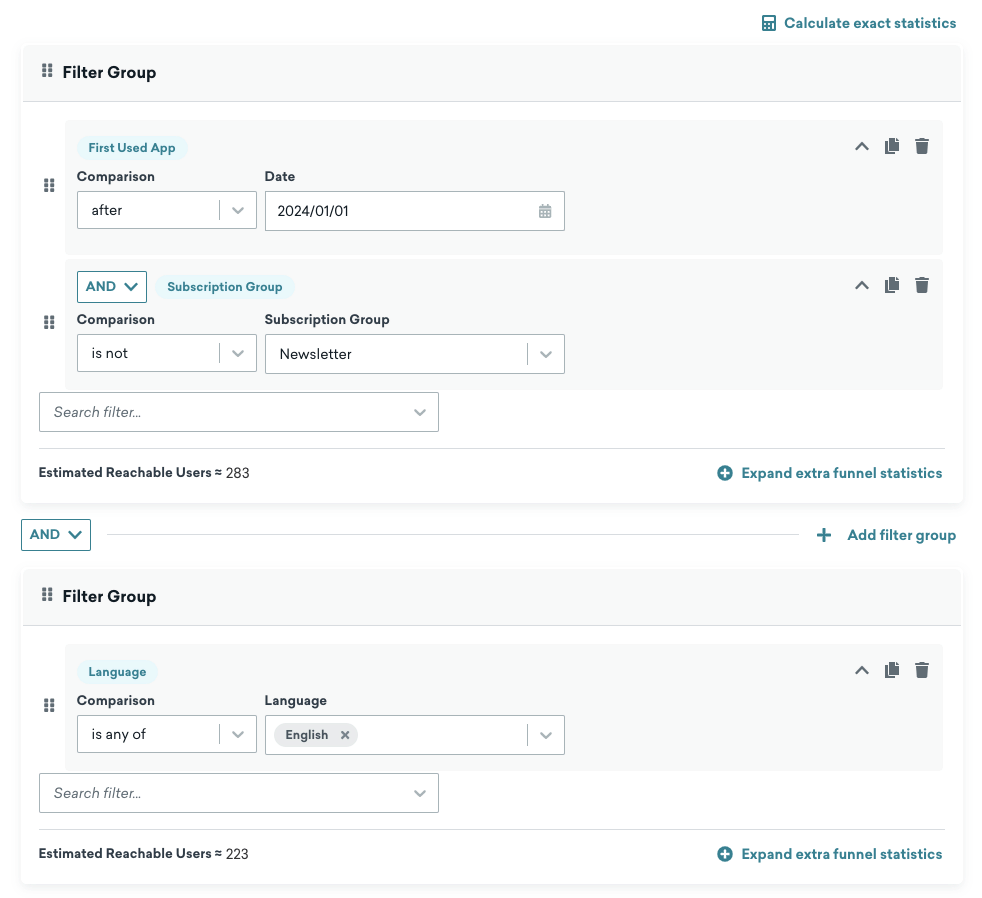
Creating a segment in Braze
Braze’s Canvas tool (their journey builder) allows branching logic, testing, and all sorts of complex journey mapping that sophisticated marketing teams crave. In essence, Braze provides the infrastructure and tools to ensure the right users get the right message on the right channel, all in real time, even at massive volumes.
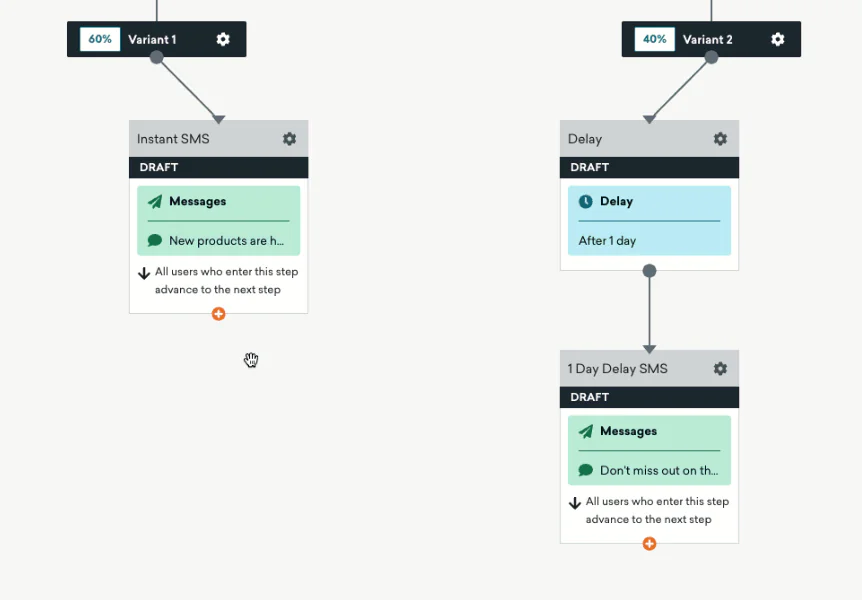
Braze’s Canvas tool
Key Features:
- Multiple channels: Natively supports mobile push notifications, web push, email, SMS, in-app messages, content cards (persisting inbox messages in app), and more. One campaign can include any combination of these.
- Braze Canvas (Journey Orchestration): A visual campaign builder to create multi-step, multi-channel journeys with branching (if user does A, go down path X, else path Y). You can A/B test entire paths or timing delays to optimize.
- Real-time data streaming: Integrates with your app/web via SDKs and APIs to get user events in real time. A user’s behavior can trigger messages seconds later, and Braze can also ingest data from external sources (like a CRM) via API.
- Intelligence Suite: Braze offers predictive tools and optimization like “Intelligent Timing” (sending messages at the time each user is most likely to engage) and “Intelligent Channel” (choosing the best channel—e.g., push vs email—for each user for a given campaign based on past behavior).
- Personalization & Content Blocks: Advanced personalization using liquid templating. You can reference user attributes or event data in messages, pull in product recommendations, or even use connected data (like live inventory or pricing info via API) in your messages.
- Analytics and Currents: Detailed campaign analytics, and Braze Currents allows you to stream data out to analytics systems or data warehouses. You can see how campaigns affect retention, revenue, etc., and export data to tools like Snowflake or Looker for deeper analysis.
- Scaling and Throughput: Braze is built to send huge volumes of messages reliably. If you have millions of contacts and need to send during a high-traffic event (say Black Friday), Braze’s infrastructure is up to the task (which is something not all smaller platforms can handle as gracefully).
- Developer Friendly & Integration: They have robust SDKs for iOS, Android, web, and a library of integrations (to import/export data). It often sits in a larger stack, connecting with CDPs like Segment or analytics tools, and it’s quite flexible in that regard.
Strengths and weaknesses
Braze’s strength is in its firepower and flexibility. It’s the kind of platform that can be as sophisticated as your strategy requires. Have a crazy idea for a campaign that involves three channels, conditional logic based on user attributes, and multivariate tests? Braze can probably do it. Marketing teams at large enterprises love that they can dream up complex customer journeys and Braze will let them build and automate those scenarios, rather than resorting to one-off manual campaigns.
Another strength is Braze’s focus on the user experience—by supporting so many channels and real-time triggers, it enables a very customer-centric approach. Instead of blasting everyone with the same message, Braze pushes you toward targeted, behavior-driven messaging. If Attentive is like a precise rifle for SMS, Braze is an entire arsenal for customer engagement. On top of that, Braze has a strong community and documentation, plus customer success teams used to working with big clients—so enterprises feel supported. The reporting is also quite granular, allowing teams to prove out the impact of campaigns or refine them with data.
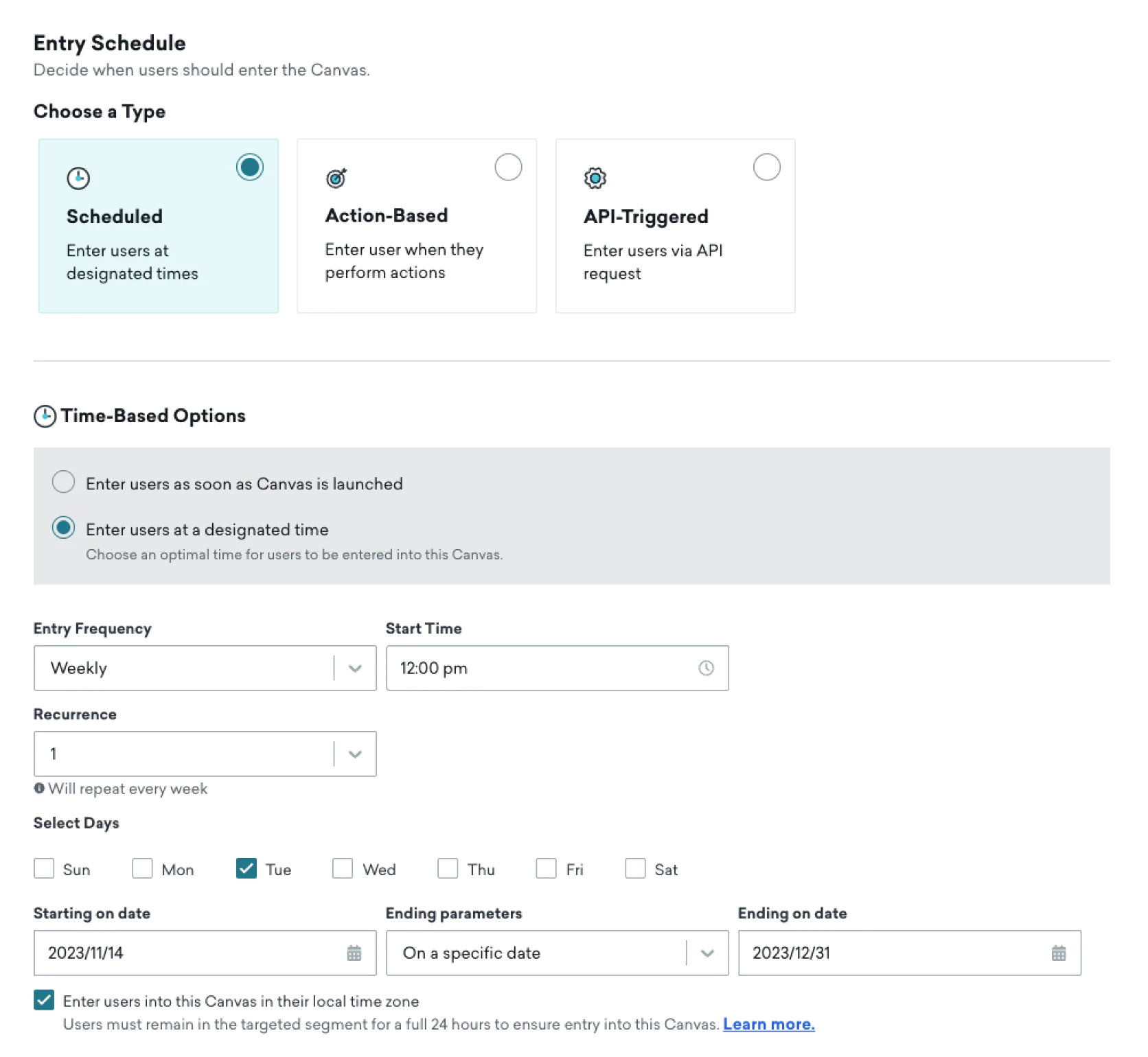
Scheduling delivery in Braze
However, with great power comes… some trade-offs. Braze is not trivial to implement or operate. It often requires developer involvement to get the most out of it (especially to instrument your app or website to send the right events and data into Braze). Smaller teams without a dedicated tech resource might struggle to fully utilize it. In contrast, Attentive or others might be more turnkey.
Braze can also be overwhelming at first—the interface and capabilities have a learning curve. Marketers might need training to use Braze effectively, whereas simpler tools can be picked up in a day.
Another weakness is cost: Braze is priced for enterprise and can be expensive, usually charging based on monthly active users or subscriber counts across channels, plus possibly message volumes. If you’re only looking to do SMS, Braze would be overkill and too pricey. It shines when you’re using many channels and have millions of users to manage; otherwise, it’s like hiring an orchestra to play a simple tune that a soloist could handle.
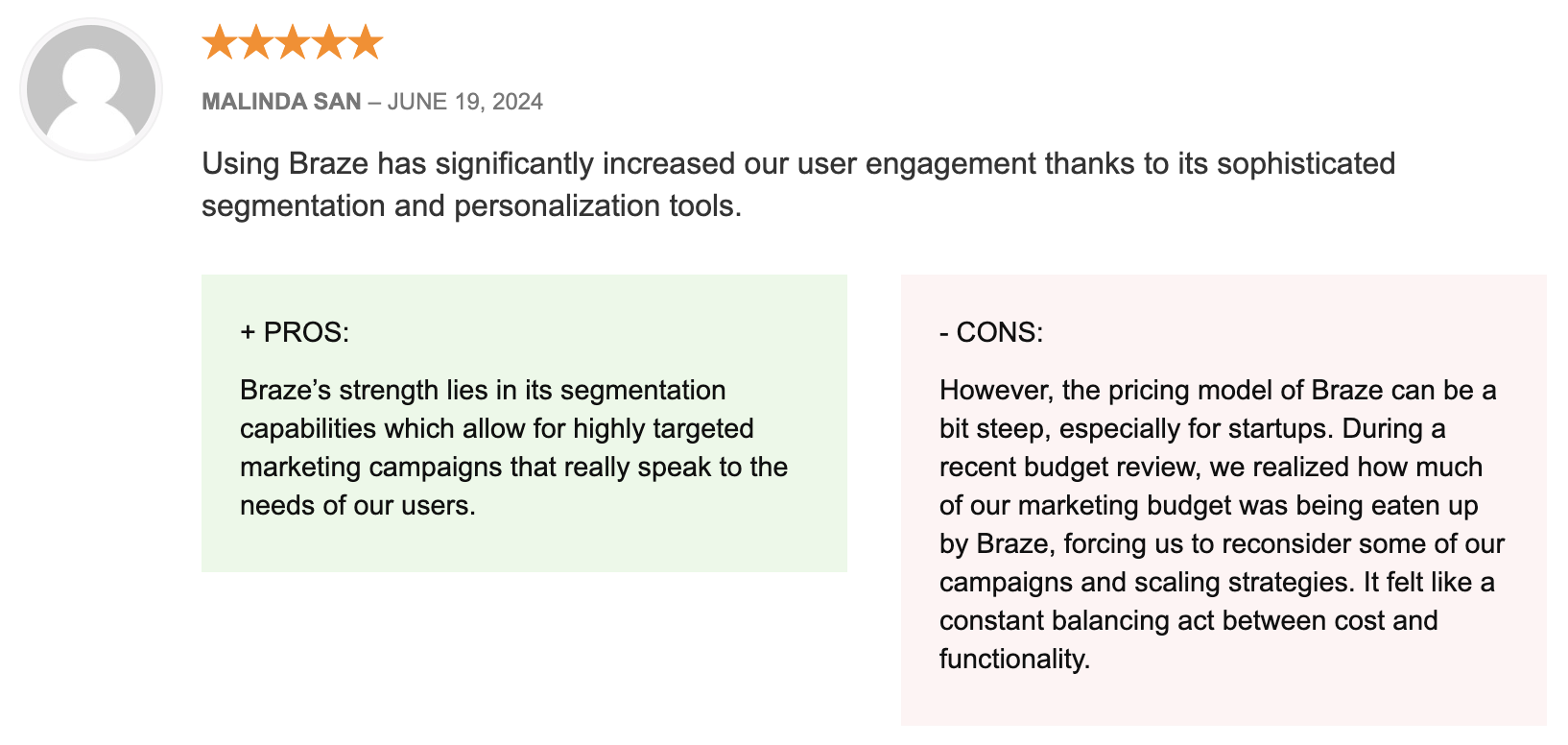
Also, for all its channels, Braze does not include some higher-level marketing features like a loyalty program or out-of-the-box review generation like Yotpo would, for example. It’s channel-agnostic engagement, so something like a loyalty tier management would be custom or external. Essentially, Braze gives you the pipes and the sending engine, but not those niche marketing programs.
And while Braze can do SMS, it’s not an SMS-only specialist—it might not have quite the same focus on SMS-specific innovations (e.g., Attentive’s unique two-way concierge or compliance services) because it’s spread across channels. Lastly, the analytics, while strong, usually require integration with your data warehouse for the full picture—some less technical marketers might find it less straightforward to get aggregated insights compared to a simpler tool’s built-in reports.
Compared to Attentive
Attentive and Braze almost live on different planets in terms of target audience. Attentive is for marketing teams that primarily want a turnkey SMS (and email) solution to drive revenue, often e-commerce focused. Braze is for cross-industry, often larger teams that want to orchestrate user communication everywhere, especially in-app and via push, not just marketing blasts.
If you compare feature to feature, Braze covers SMS (as one channel among many), but it doesn’t offer the kind of specialized SMS services Attentive does like helping with carrier provisioning or dedicated short codes as proactively, because enterprises usually handle that or Braze assumes you know what you need. Braze’s SMS is typically used alongside push and email for companies with apps (e.g., a ride-share service sending you an SMS if you haven’t opened their push).
For a pure e-commerce retailer, Braze can be somewhat complex if you don’t utilize the mobile/app capabilities. Meanwhile, Attentive is quite specifically optimized for retail use-cases like cart abandonment texts or product drop alerts via SMS.
In terms of channel breadth, Braze far outstrips Attentive—Attentive adds maybe email and some social integration, but Braze does push, in-app, even webhooks to trigger external actions. So if a brand’s looking at expanding beyond SMS/email, Braze is a logical step up.
On ease-of-use, Attentive probably wins for a marketing person; Braze might require more technical know-how. Attentive often acts as a “strategic partner” for you (with their customer success suggesting campaigns, etc.), whereas Braze is more “here’s the keys to the Ferrari, do you know how to drive it?”—they’ll support you, but they expect you to have the pit crew (either internal or via solutions partners).
Cost-wise, if Attentive felt expensive, Braze could be even more so, unless you’re cutting other tools and consolidating into Braze.
Another notable difference: Attentive’s strength is two-way conversational SMS for commerce (they highlight how you can chat with customers via text). Braze supports two-way (you can get replies and respond or trigger flows based on keywords), but it doesn’t emphasize a managed conversational service. Braze is more about automation at scale; Attentive is also about one-to-one engagement via text with the help of their Concierge.
In summary, if a company is currently only doing SMS with Attentive and contemplating Braze, it’s likely because they need to integrate more channels (maybe they launched an app, or they want to unify messaging). Attentive could start to feel limiting in that case. Braze offers a world of multi-channel possibilities Attentive can’t match, but it also demands more investment in setup and talent to harness it.
For a sophisticated team ready to go omnichannel, Braze is a top-tier alternative. For a team that just wants to improve SMS results, Braze might be overkill compared to Attentive.
Compared to Maestra
Braze and Maestra have some overlap in that both aim to provide omnichannel marketing capabilities, but they come from different angles. Braze’s heritage is in product and app messaging—it excels at operationalizing messaging for tech companies (think streaming services, mobile apps, etc.) as well as large brands. Maestra’s focus is squarely on marketing for commerce—including things like loyalty, promotions, and on-site personalization that Braze doesn’t provide out-of-the-box.
In a way, Maestra attempts to bundle the best of several worlds: the cross-channel messaging of a Braze, the loyalty of a Smile.io, the personalization of an Optimove, etc., into one. Braze, on the other hand, sticks to being a communications platform and relies on you to integrate any loyalty or advanced marketing logic from elsewhere.
A key difference is accessibility and support. Maestra provides a lot of white-glove service and is designed so that a marketing team can use it without needing a squad of engineers. Braze, while marketer-friendly in interface, typically still needs engineers to pipe data in correctly and possibly to manage templates for in-app messages, etc. If a brand doesn’t have that engineering support, Maestra would be a gentler experience because Maestra’s team helps with those heavy lifts and the platform is tailored to not need as much custom dev work to get common use-cases going.
For example, implementing a loyalty program trigger in Braze means your app or backend has to send Braze an event when someone’s loyalty points change, and then you craft a campaign around that. In Maestra, the loyalty program is built-in, so those triggers are native and easier to configure by a marketer.
In terms of capabilities, Maestra matches Braze on channels like SMS, email, push, and also adds the on-site and loyalty angles.
Maestra has a real-time CDP that’s arguably more marketing-friendly—it’s built to house purchase history, product catalog, etc., and make that usable quickly for segmentation. Braze often relies on integrating with an external CDP or data warehouse for the richest segmentation (Braze can store a lot of data per user, but complex segment logic sometimes needs data pre-processed). So Maestra might let a marketer create a complex segment more easily through its interface, whereas Braze might expect some computed custom attributes fed in to simplify segmentation.
When it comes to choosing between them, a brand that is very app-centric or has a wide non-commerce user base (like a media app or a fintech service) might lean Braze, because that’s Braze’s sweet spot. A brand that is commerce-centric and wants a more turnkey growth platform might lean Maestra, as it covers more of those needs out-of-the-box.
Also, Maestra includes the strategic guidance in the package, whereas with Braze you might hire consultants or have an internal CRM team to strategize.
In essence, Maestra provides an all-in-one growth engine with handholding, whereas Braze provides a powerful multi-channel engine and expects you to drive it. They can achieve similar outcomes—highly personalized, timely messages across channels—but Maestra bundles more marketing-specific functionality on the platform and service side, while Braze offers a bit more raw configurability.
Tool #5: Omnisend
Best Attentive alternative for all-in-one email & SMS marketing for SMBs
Omnisend is an email and SMS marketing platform designed for small to mid-sized e-commerce businesses. It positions itself as an affordable, easy-to-use alternative to tools like Klaviyo, with the bonus of also handling web push notifications. For brands that want to manage email campaigns, automated sequences, and text messages without juggling separate systems, Omnisend offers a unified solution.
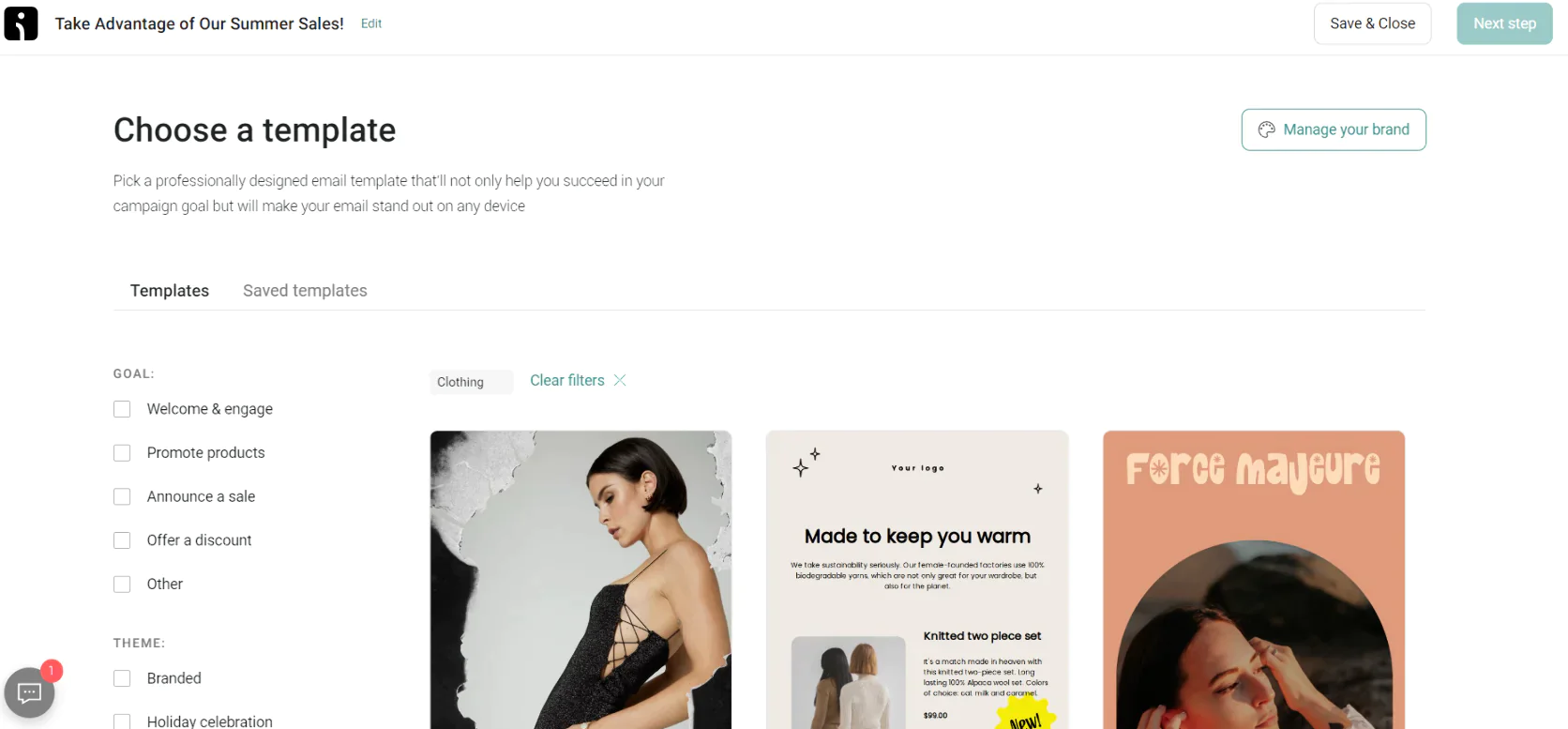
Omnisend’s email templates
It integrates nicely with e-commerce platforms like Shopify, BigCommerce, and WooCommerce, pulling in product and customer data to fuel your marketing.
One of Omnisend’s calling cards is its library of pre-built automation workflows tailored to e-commerce—things like welcome series, cart recovery, browse abandonment, order confirmations, and reactivation campaigns are available as templates that you can activate with a few clicks. This is great for smaller teams who may not have the time to build complex automations from scratch.
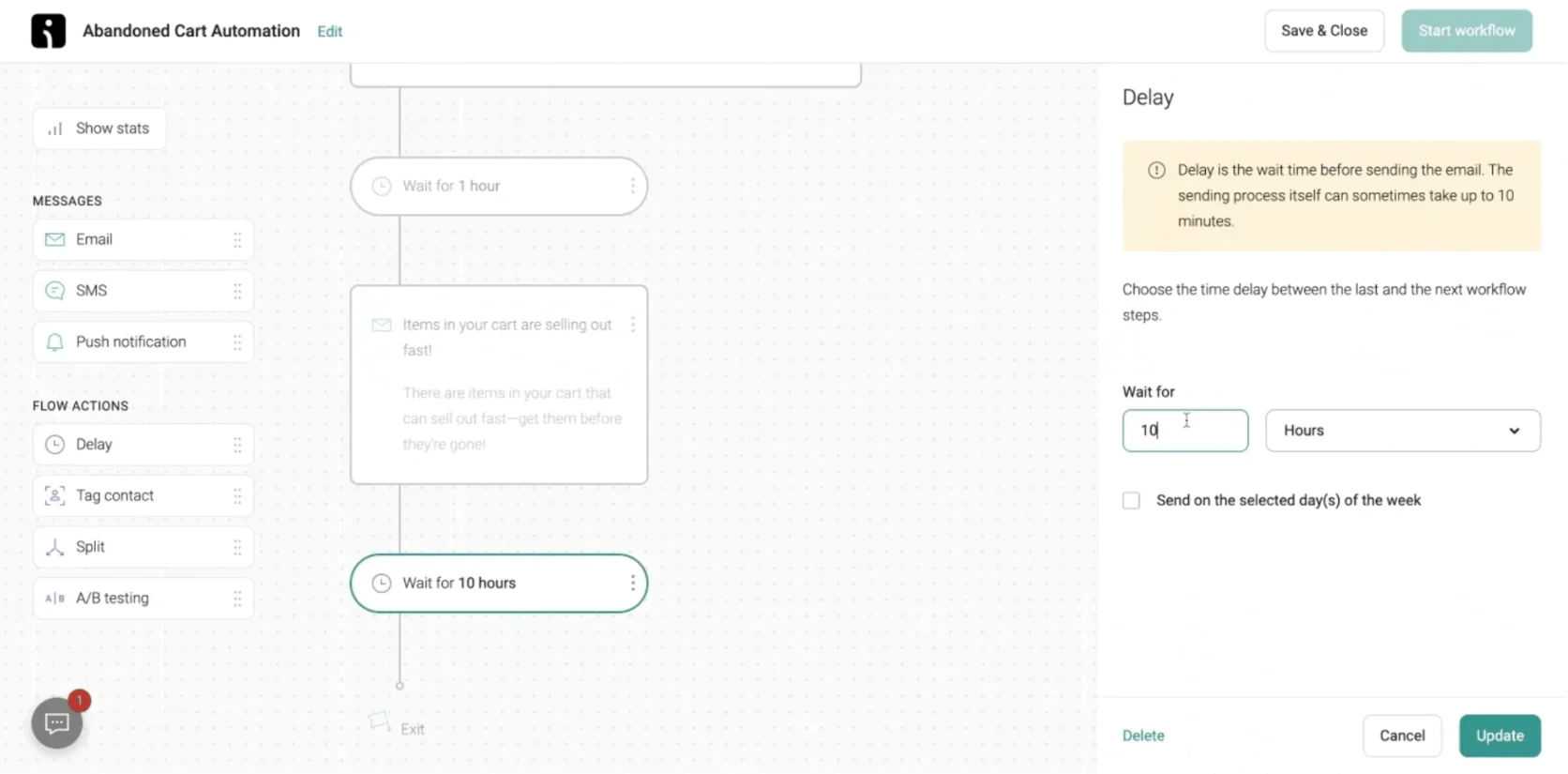
Omnisend’s pre-build abandoned cart automation
Omnisend also includes a modest SMS capability (you can send text campaigns or add SMS steps in your automation workflows) and supports basic web push notifications, making it more multi-channel than Attentive’s core offering. In summary, Omnisend aims to cover the marketing needs of an online store in one place: capturing subscribers, emailing them, texting them, and even nudging via push—all with a friendly interface and at a budget that smaller businesses can handle.
Key Features:
- Email & SMS campaigns: Create branded emails with a drag-and-drop editor, and send SMS messages. Both can be combined in the same campaign workflow (e.g., send an email, then an SMS follow-up to non-openers).
- Pre-built automations: Ready-to-use workflows for common scenarios like cart abandonment, welcome series, order/shipping updates, customer reactivation, etc. These come with recommended timing and messaging which you can customize.
- Segmentation: Segment customers based on shopping behavior (purchases, amounts, products), email engagement, or profile data. It’s not as granular as enterprise tools, but sufficient for targeted campaigns like “VIP customers” or “Category X Browsers.”
- Sign-up forms & pop-ups: Built-in tools to create email pop-ups, landing pages, or even a wheel-of-fortune signup game to capture emails/phones on your site. This helps grow your list for both emails and SMS consents.
- Web push notifications: Ability to capture browser push subscribers and send web push messages (like back-in-stock or flash sale alerts) that appear on a user’s desktop or mobile browser even if they’re not on your site.
- Campaign booster: A one-click feature to resend emails to those who didn’t open the first send (you can automatically resend with a different subject line to try getting a second chance at engagement).
- Reporting: Dashboard that shows sales, clicks, and engagement from your campaigns and automations. Omnisend’s reports highlight the sales generated from each automation (e.g., your cart recovery workflow brought in $X revenue this month).
- Integrations: Apart from e-com platforms, it integrates with review apps, loyalty apps, and a few other tools to centralize data. Also has integration to Google Ads and Facebook Ads for syncing email lists to ad audiences (useful for retargeting).
- Pricing model: Often provides a free tier (for email up to certain contact count) and charges as you upgrade for more contacts and if you add SMS credits. Typically, it’s more affordable at the entry-level than some competitors, making it attractive to budget-conscious marketers.
Strengths and weaknesses
Omnisend’s strength is definitely in its accessibility and value for money. For an SMB, being able to set up relatively advanced automations with a few clicks is a huge win—you can start recovering abandoned carts or sending post-purchase review requests without deep technical skills.
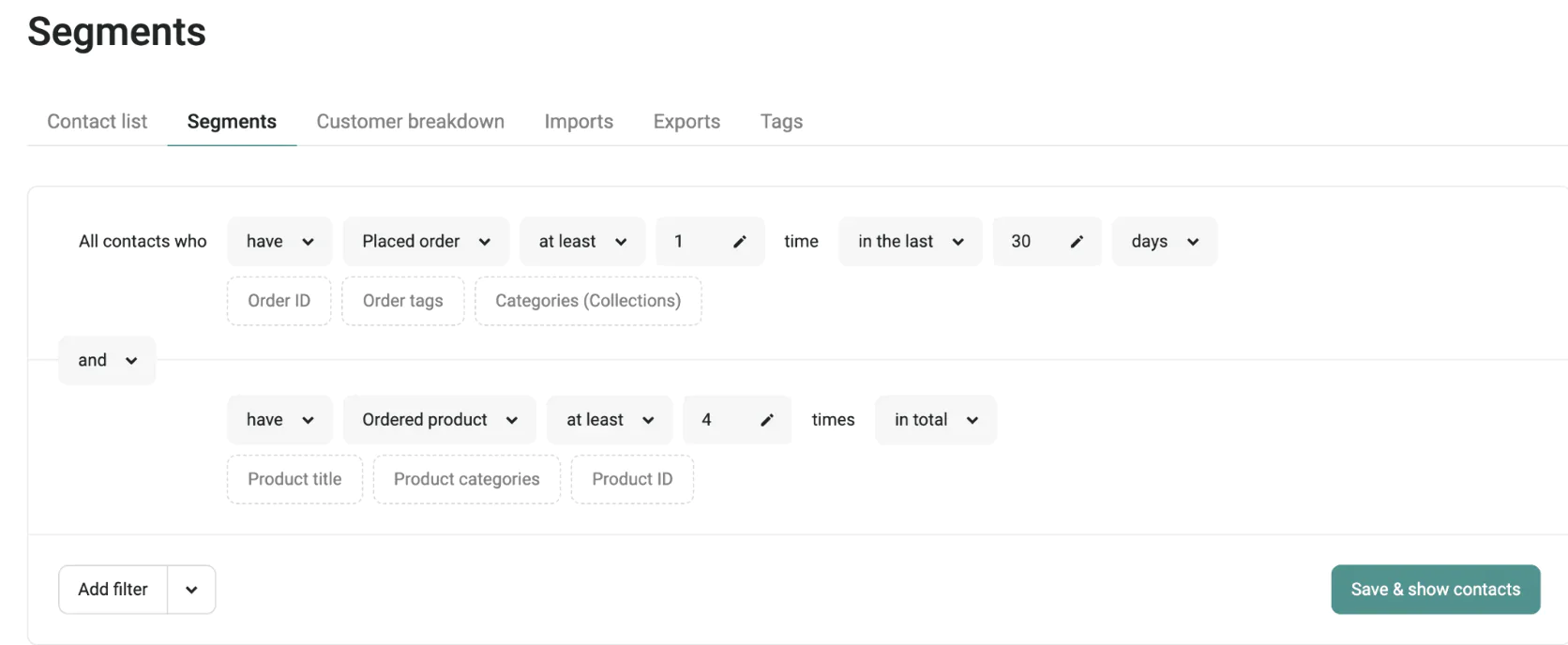
Omnisend’s segment builder
The interface is geared towards marketers who may not be experts; it’s clean and simpler than something like Braze or even Klaviyo. Everything in one place (email, SMS, push) means you don’t have to learn or pay for multiple systems.
Another plus: Omnisend’s customer support and onboarding are often praised by users, which is important for smaller businesses that might need extra help getting set up.
The platform continuously rolls out new e-commerce-centric features (they recently beefed up things like product recommender blocks in emails, etc.), showing they are focusing on what store owners need. Also, the inclusion of web push is a nice touch—it’s a free channel (doesn’t cost per send like SMS or email) and can add a few percentage points of extra reach/ sales if used well, and not all competitors include push in the mix.
On the downside, because Omnisend aims to be easy and affordable, it may lack some of the advanced sophistication of pricier or more specialized tools. For example, its segmentation, while useful, isn’t as deep as what you’d get in a dedicated CDP—you might not be able to create ultra-nuanced segments combining dozens of criteria.
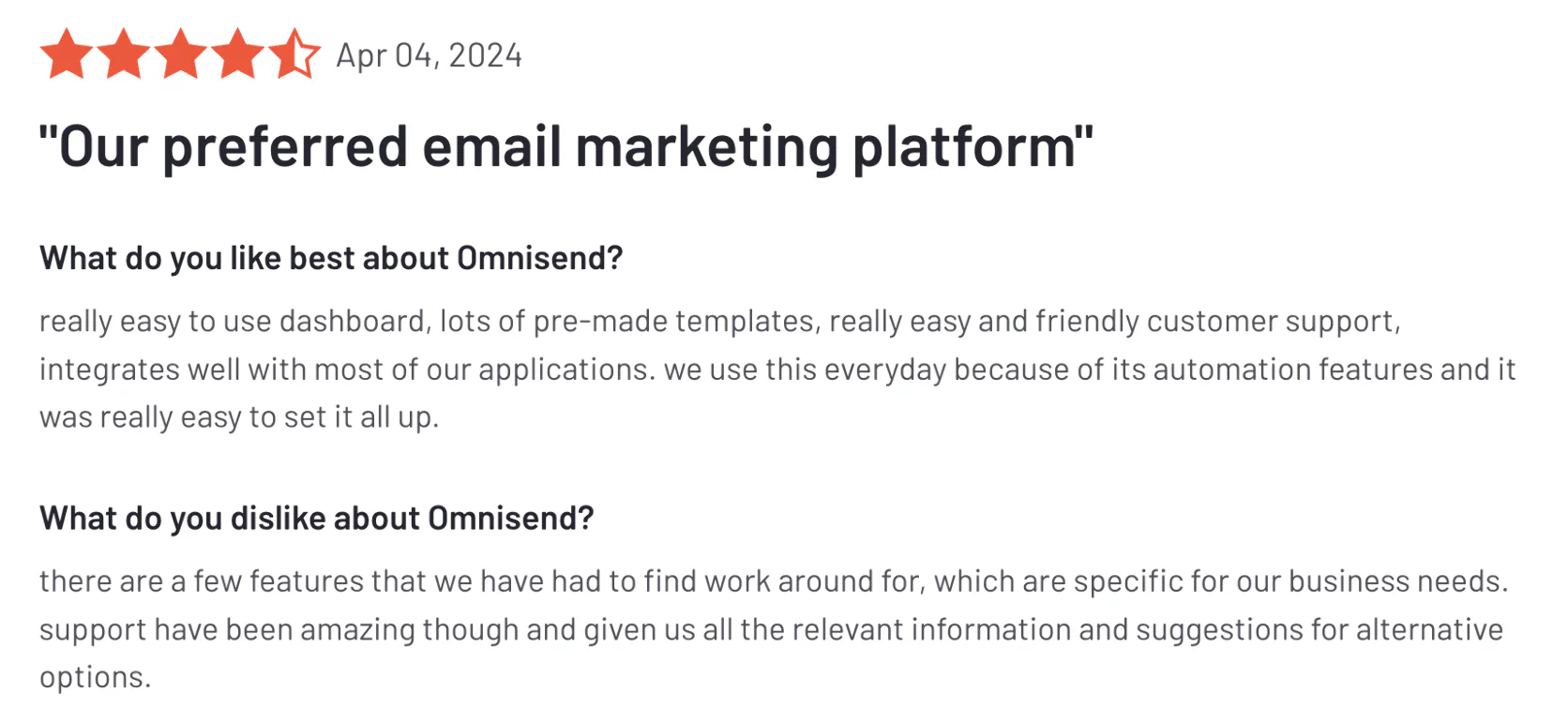
The email builder, while user-friendly, could be limiting if you want highly custom designs or complex dynamic content (it’s improving, but agencies sometimes prefer more flexibility). Also, while Omnisend does offer SMS, it’s somewhat region-limited—it’s strong in certain areas (like U.S., Europe) but might not support all countries as robustly as a dedicated SMS platform, and its SMS feature set is more basic (Attentive’s two-way chat or advanced compliance handling outstrips Omnisend’s simple send-and-receive capability).
In terms of deliverability, Omnisend is generally good but doesn’t give as much granular control as advanced email platforms (e.g., managing dedicated IPs, fine-tuned domain warmups—though for most small businesses that’s overkill anyway).
A potential weakness is scalability: an SMB might love Omnisend, but as they grow to enterprise level, they might start to feel limitations—be it in reporting depth, speed, or integration flexibility.
Essentially, Omnisend covers 80% of what most small-medium e-com brands need, but that extra 20% (complex analytics, super personalization, multi-channel beyond what’s included) could require a move upmarket (to a Maestra or Braze or similar) later on. But for its target market, Omnisend keeps things intentionally straightforward, which is a fair trade-off.
Compared to Attentive
For a small or mid-sized brand, comparing Attentive to Omnisend is like comparing a specialized sports car to a reliable hybrid sedan. Attentive specializes in one thing (SMS, with some email now) and does it flashily (AI, promise of huge ROI via text). Omnisend is offering a broader, more balanced package (email + SMS + push) at a cost that SMBs can stomach.
If you’re already using Attentive for SMS and another tool for email, Omnisend could replace both in one go, which is appealing from a cost and simplicity perspective. Attentive’s SMS capabilities might be a bit more advanced—for example, Attentive has that two-way concierge and very refined SMS templates for things like compliance messaging. Omnisend’s SMS is more straightforward: you schedule or automate texts, you can receive replies but it’s not positioned as a conversational channel with AI handling it. Attentive might yield more SMS-driven revenue if you fully leverage their bells and whistles, but then you’d still need to handle email separately.
Omnisend’s email capabilities far exceed Attentive’s basic email add-on. So, if email marketing is an equal priority to SMS for you (and it usually is for e-com), Omnisend offers a more robust solution there (better email design tools, more email automation, etc.).
Another aspect is pricing transparency and control. Attentive’s pricing can be opaque and often expensive for small folks, whereas Omnisend’s pricing is transparent on their site, with free plans and predictable tiers—no surprise overages except if you send a ton of SMS (but you buy those as needed). Many small brands simply won’t qualify for Attentive’s higher-touch service or large minimums; they can get started on Omnisend for free or cheap and see results.
However, Attentive’s focus means they might have higher SMS click-through or conversion rates, potentially, since they fine-tune text strategies with you. But if Attentive’s email is lacking, overall performance may suffer in the multi-channel sense. Omnisend encourages using a combo: maybe you send an email first, then a text to those who didn’t open or purchase—you can orchestrate that easily in Omnisend, something Attentive alone can’t do (Attentive can’t know who ignored your email from Mailchimp, for example, whereas Omnisend knows because it was running the email).
So, compared to Attentive, Omnisend is more of an all-in-one marketing solution albeit a bit less flashy. A brand that needs to maximize every dollar and prefers a simpler tech stack might choose Omnisend over juggling Attentive + another email platform. On the other hand, a brand that has a large SMS list and wants to push SMS performance to the max, and maybe has budget for separate best-in-class tools, might lean Attentive (and then pair it with something else for email).
One more thing: Attentive’s support is more high-touch for big clients (like they provide strategic guidance), whereas Omnisend, while supportive, is more self-serve/tech support oriented.
Overall, Omnisend offers a compelling “good enough” alternative to Attentive that also solves additional problems at a lower cost, which for many is a winning proposition.
Compared to Maestra
Omnisend and Maestra have a bit of a David vs Goliath dynamic, but in a friendly way. Omnisend is aimed at the little guys, Maestra is geared more toward rapidly scaling brands and mid-to-large enterprises who want all the power.
Maestra encompasses Omnisend’s capabilities and then some—what Omnisend does for email/SMS, Maestra also does (often with more advanced features on each channel, like more sophisticated segmentation), plus Maestra layers on a real-time CDP, loyalty programs, on-site personalization, etc.
So, a brand using Omnisend might eventually hit a ceiling: maybe they want to do real-time personalized content on their homepage based on a user’s email behavior, or they want a tightly integrated loyalty program driving their emails and texts—Omnisend can integrate with loyalty apps but doesn’t have its own; Maestra has it built-in.
Another example: Omnisend’s push notifications are basic one-off or automated pushes. Maestra’s push could be part of a larger journey and coordinated with web personalization, which Omnisend doesn’t do at all.
From a support perspective, Omnisend is more DIY, whereas Maestra is that full-service partner model. A company might start on Omnisend and do well, but as they grow, they might value more guidance or bespoke solutions—Maestra provides a dedicated CSM who actively works on your account strategy, which Omnisend (at its price point) can’t offer.
Also, scale and optimization: Maestra’s infrastructure is built to handle enterprise volumes and real-time decisions at scale. Omnisend works great for moderate lists, but if you become a huge retailer with millions of contacts and complex data, you’d likely consider upgrading to a platform like Maestra (or others in that tier) for reliability and sophistication.
In summary, Omnisend is sort of an entry-level tool and Maestra is high-end. They’re alternatives to Attentive in different segments. Omnisend is cost-effective but limited to simpler tactics. It’s a trade-off between “keep it simple and cheap” versus “invest to unlock big growth levers.”
If a brand aspires to do what the big players do (real-time personalization, unified multi-channel, etc.) and has the growth to warrant it, Maestra would be the choice. If they are more constrained or simply don’t require those extras yet, Omnisend might serve them perfectly well for a long time. In a way, Maestra could be seen as what you graduate to if you outgrow Omnisend.
Tool #6: Emotive
Best Attentive alternative for two-way conversational SMS marketing
Emotive’s campaign flow interface for two-way conversations. Emotive is a unique player in the SMS marketing arena, billing itself as a platform for “conversational commerce” via text message.
While Attentive and many others allow two-way messaging, Emotive puts that front and center by combining automated texts with real human interaction. The idea is that when a customer replies to one of your campaign texts—say, asking a question about a product—Emotive’s system can hand the conversation off to a live agent (an e-commerce sales rep or support agent on your team, or in some cases an agent provided by Emotive’s service) who continues the conversation, driving toward a sale or resolution.This hybrid approach aims to give consumers a feeling of personalized, real conversation over SMS, rather than just receiving blasts or bot-like replies.
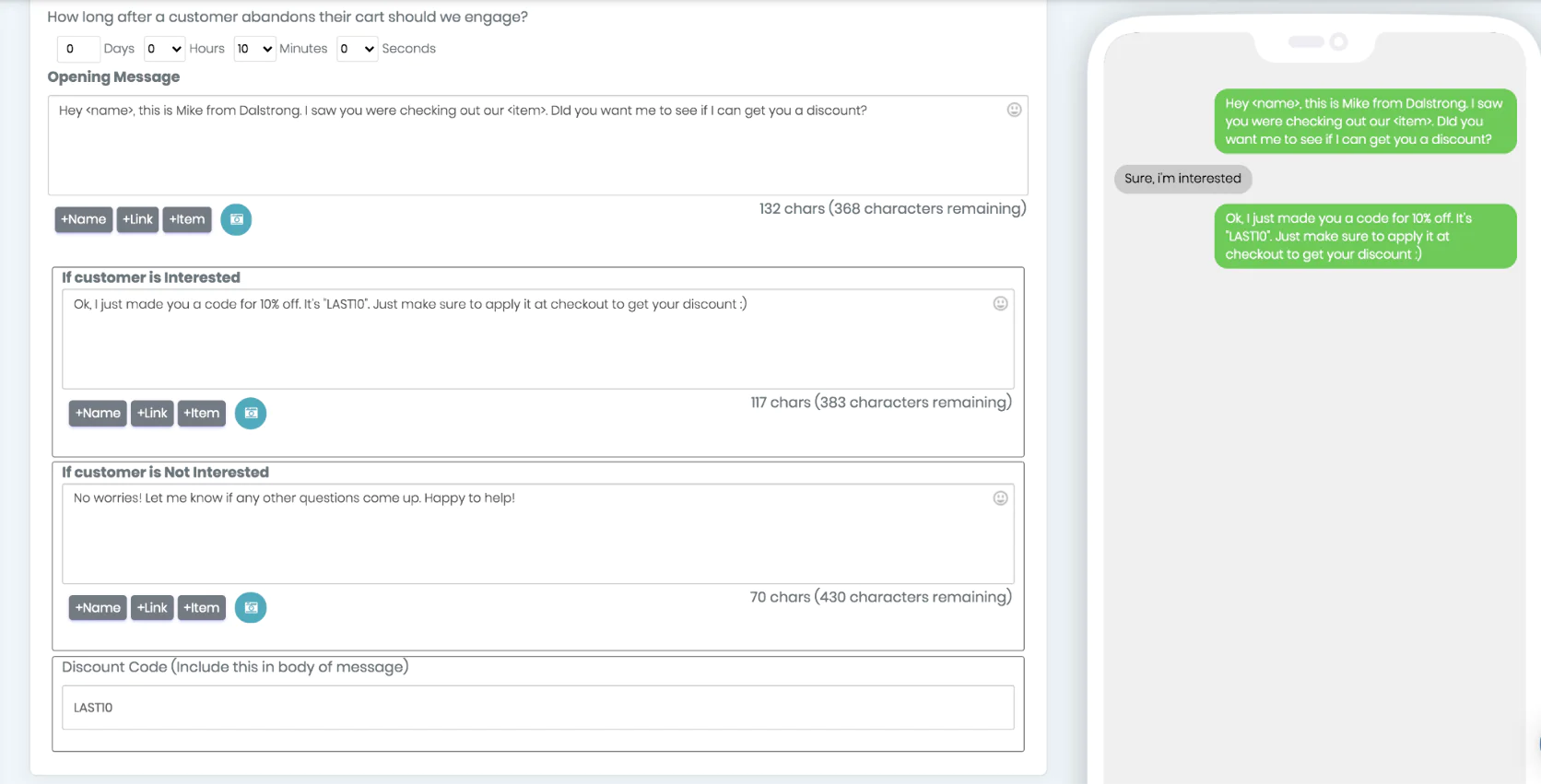
Setting up conversational texting abandoned cart in Emotive
Emotive integrates with Shopify and other e-com platforms to pull in customer and order data, so agents (and the system) have context on who they’re texting (past purchases, browsing history if tracked, etc.).
Emotive also provides an AI assistant that helps manage the flow: it can handle simple responses or FAQs initially—for example, if someone texts “How do I track my order?”, the AI can recognize that and send the tracking info—and route more complex queries to a human.
For a brand, using Emotive means when you send out an SMS campaign, you’re not just sending a message, you’re implicitly opening a chat channel with customers. The platform includes a dashboard for viewing and responding to ongoing text conversations, tools to trigger campaigns or one-on-one outreach, and analytics on the outcomes (like how many conversations led to a purchase).
Key Features:
- Conversational SMS campaigns: You can create SMS campaigns that invite reply (e.g., a question, a quiz, or a simple prompt like “Have questions? Just reply”). Emotive’s AI and agents stand by to handle the responses at scale.
- Human + AI agent system: Emotive combines AI-driven first responses with real human agents. The AI can greet or handle common questions, then ping a human agent to step in for higher-value interactions. This keeps response times quick without losing the human touch.
- Segmentation and targeting: Similar to other SMS platforms, you can segment who you text based on behaviors or attributes (browse history, purchase history, etc.). This ensures the conversations are targeted (e.g., only text about product X to people who showed interest in product X).
- Integration with e-commerce data: Emotive connects with platforms like Shopify, so agents can see order history, modify orders, issue discount codes, etc., directly as they chat, which makes the conversation truly commerce-enabled.
- Campaign types: Beyond standard promos, Emotive supports two-way campaign structures like product quizzes (text-based Q&A to recommend a product), feedback collection (e.g., post-purchase “How do you like your product? Any issues?” leading to service recovery or upsell), and VIP concierge outreach (“Hey, we noticed you left something in your cart—any questions we can answer?”).
- Compliance and opt-in tools: Emotive provides tools to capture consent (keywords, short codes, forms) and handles opt-out requests automatically with proper compliance messaging, important for legal texting.
- Analytics and ROI tracking: The platform tracks revenue generated from SMS conversations. For instance, if an agent provides a special link or code and the customer purchases, that sale is attributed back to the conversation. You can see metrics like conversion rate of conversations, average order value from text customers, etc.
- Managed service option: Emotive offers a team of their trained “concierge” agents who can represent your brand in these text conversations, if you don’t have staff to dedicate. This is a big differentiator; they essentially offer outsourcing of the conversational texting to experts (for an added fee), which can be appealing to brands that love the idea of one-to-one texting but can’t staff it 24/7.
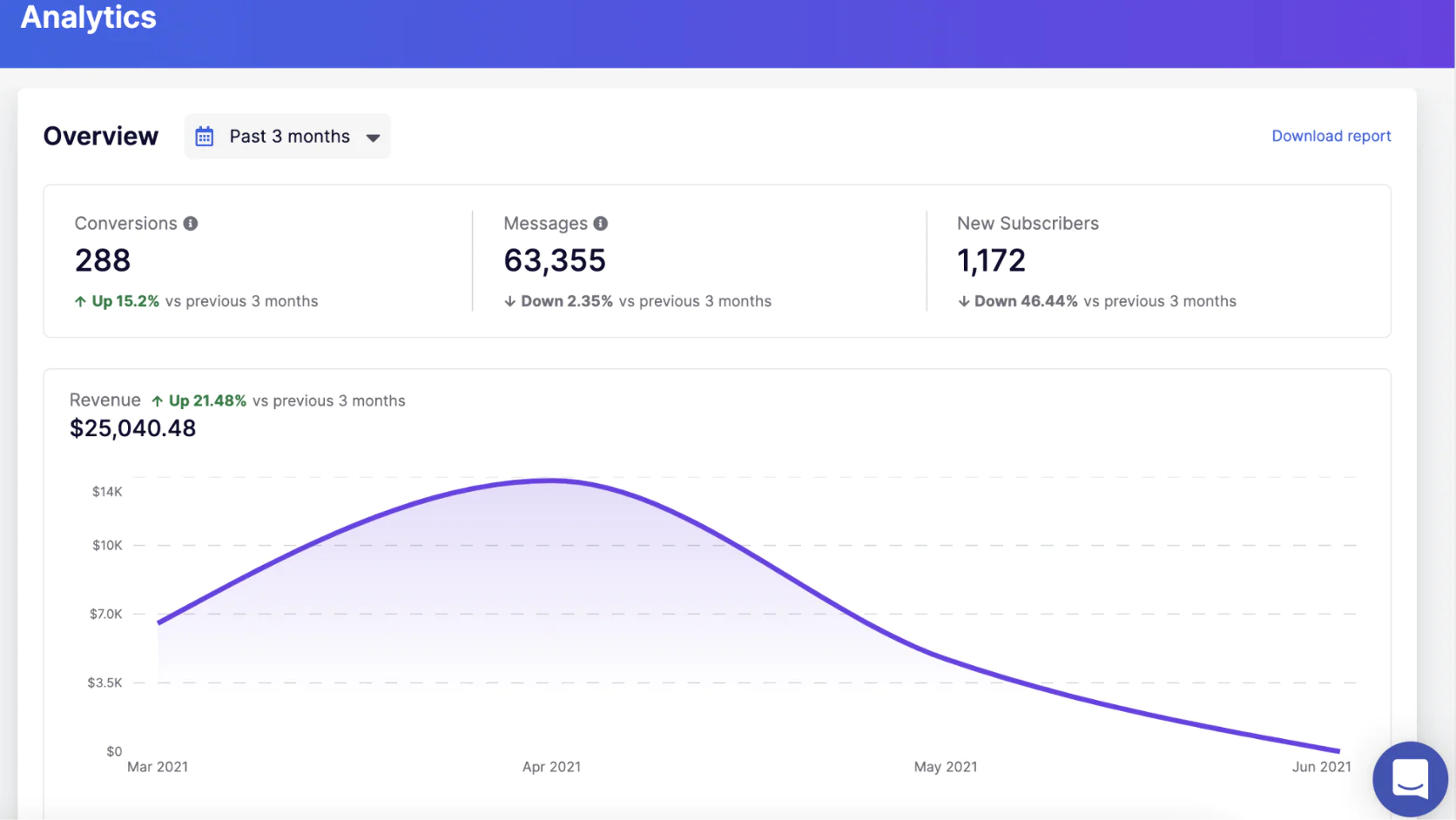
Emotive’s Reporting
Strengths and weaknesses
Emotive’s strength lies in the personalized customer experience it facilitates. In an era where consumers are bombarded with impersonal marketing, actually having a conversation with a brand via text can really stand out. Many shoppers have questions or hesitations that, if resolved in the moment, lead directly to a sale—Emotive capitalizes on that by making SMS interactive. This often translates to higher conversion rates from SMS campaigns. Instead of just sending a coupon and hoping they use it, you’re effectively replicating the in-store sales associate experience: “Can I help you find something or answer any questions?” That can boost confidence and push customers over the line.
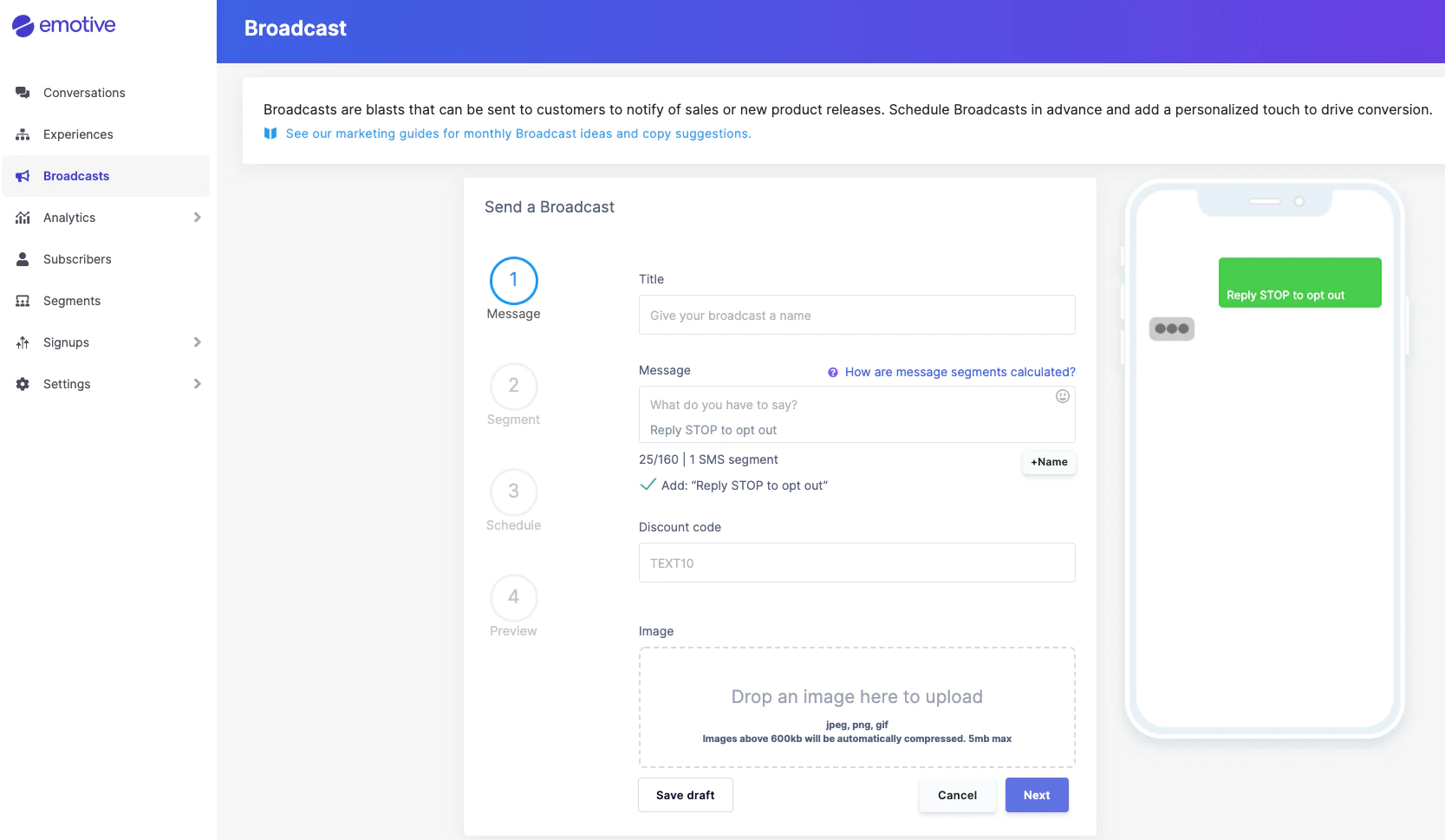
Emotive’s Broadcast Lab
Emotive clients often see strong ROI because those conversations can recover potentially lost sales (like abandoned cart recovery through a personal nudge). Another strength is the blend of AI and human. Pure AI chatbots can be frustrating when they hit their limits, but Emotive’s use of humans for the nuance ensures the customer feels heard and assisted, not stuck in an endless loop of “Sorry, I didn’t get that.” For brands with smaller catalogs or higher-touch products (like luxury goods or electronics that people might have questions about), this approach is golden. Also, Emotive makes it relatively easy—they train their agents to know your FAQs and tone, so even the outsourced approach can feel consistent with your brand voice.

Abandoned Checkout flow in Emotive
Weaknesses of Emotive include scalability and cost. While they do their best to automate, the model inherently involves human labor. If you suddenly need to engage thousands of customers in text conversations, you either need a big team on your side or to pay Emotive’s team to handle it. This can get expensive—likely more expensive than a typical SMS platform where you just pay per message. It’s the difference between running an email blast vs. running a call center, metaphorically. So, brands must ensure the increased sales justify that cost.
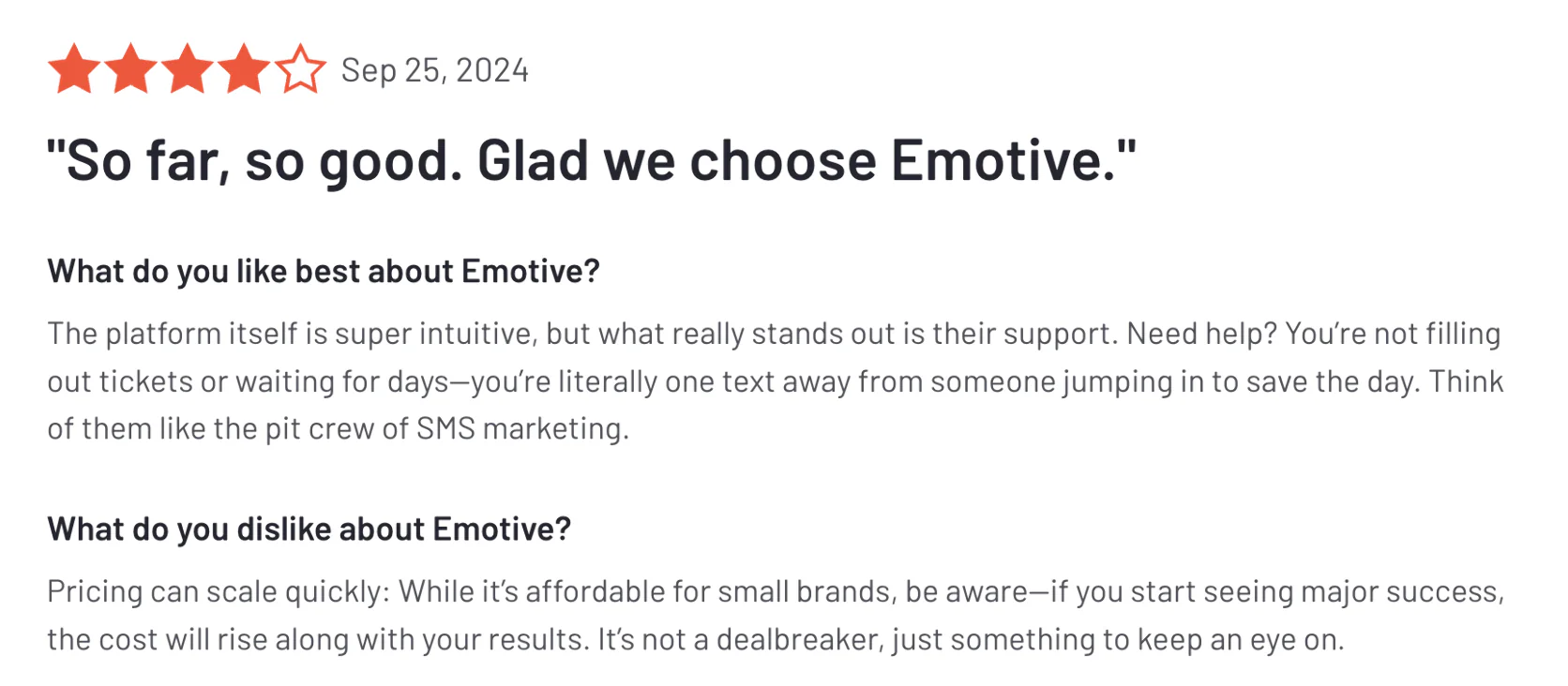
Another potential downside is not every consumer wants to chat. Some might find it intrusive if a brand starts texting them and trying to chat when they only expected a one-way promo. Emotive campaigns need to be crafted carefully to ensure you’re engaging those who are interested and not annoying those who aren’t—otherwise you risk higher opt-out rates. Compared to Attentive’s approach of mostly automated personalized messaging, Emotive’s reliance on human interaction could be seen as less efficient from a pure tech standpoint. Also, if a business already has live chat on their site or robust customer support, they may find overlapping efforts (e.g., an agent answering the same question on live chat and via Emotive). It requires coordination.
Emotive’s platform as a software may also not be as feature-rich in non-conversational aspects—for example, it doesn’t focus on email, push, etc., so it’s not a one-stop shop; it’s an add-on specifically to supercharge SMS with conversation. And as a relatively newer concept, measuring its success can be tricky—one needs to look at conversation-to-sale conversion metrics, which is a bit different from standard campaign metrics. Overall, Emotive’s approach can be highly effective, but it’s best suited for brands that benefit from customer dialog and are prepared to invest in making the most of that dialog.
Compared to Attentive
Attentive and Emotive share the SMS channel, but their philosophies diverge. Attentive emphasizes scale and automation with personalization, whereas Emotive emphasizes conversation and human touch. If you’re currently using Attentive, you might be sending out more “campaign” style texts—even if segmented and targeted, they’re largely one-way, aside from maybe automated responses to certain replies. With Emotive, you’re embracing a strategy where every customer reply is an opportunity for a back-and-forth interaction.
So, one consideration is the nature of your product and customers. If customers often have questions, or if your product benefits from consultation (imagine cosmetics, where someone might want to find the right shade, or electronics, where specs could be discussed), Emotive can offer something Attentive doesn’t: real-time, personal assistance over SMS.
Attentive’s scale vs Emotive’s intimacy: Attentive can blast out huge volumes and rely on its AI for some personalization (like insert first name, maybe product recommendations to segments, etc.), and it might trigger follow-ups based on behavior (like a reminder text if no purchase, etc.). Emotive will treat each send as the start of a possible chat session. So for example, Attentive might send a “We saw you left items in your cart” text with a link. Emotive might send “You left something in your cart—do you have any questions about it? I’m here to help!” The latter invites engagement.
It could recover more carts through direct assistance, but maybe fewer people will respond at all (some might prefer just the link and not want to chat). It’s a different style, possibly appealing to different customer segments.
From a resource standpoint, Attentive might require less of your team’s time day-to-day (since it’s automated campaigns), whereas Emotive may require you to have staff or pay their staff to be on those text conversations. Attentive’s pricing is about platform + usage; Emotive’s pricing will include charges for those managed conversations or agent time. If you have the support budget, Emotive can double as a sales channel and a support channel. If you don’t, Attentive’s mostly automated approach might be safer.
Customer preference is another factor: Younger consumers might love texting a brand and getting answers quickly; others might find it odd. But given the prevalence of messaging, more and more consumers are open to it. Attentive’s approach is more like “we send you info and deals,” Emotive’s is “we text like a friend who works at the store.”
Also, Attentive is starting to implement some conversational features (they acquired a company called Tone which did conversational SMS, similar concept to Emotive). So Attentive is aware of that angle—but Emotive was built around it from the ground up. Emotive might have better workflows for handing off to agents, whereas Attentive’s initial implementations might be simpler.
If comparing outcomes: an Attentive campaign might boast high click rates, Emotive might boast higher conversion per conversation. Emotive could lead to bigger basket sizes too because an agent could upsell (“that shirt would go great with these pants, want me to add? we can give you 10% off as a bundle”). That’s stuff an automated text won’t do elegantly.
In summary, if Attentive feels too impersonal or you see missed opportunities to truly engage customers via text, Emotive is a compelling alternative. Conversely, if your SMS program is running fine with mostly one-directional pushes and you don’t see a need for live interaction (or can’t support it), Attentive’s model may suffice. Emotive essentially differentiates itself by focusing on turning SMS into a conversation channel, whereas Attentive treats SMS as a broadcast/marketing channel (with minor exceptions). Depending on your strategy, one will fit better. Some brands even use both: Attentive style for certain blasts, Emotive style for high-value segments or specific touchpoints where conversation matters. But for an “alternatives” discussion, Emotive stands out as the choice if you prioritize engagement quality over sheer quantity in SMS.
Compared to Maestra
Maestra and Emotive are actually quite complementary in theory—one is an omnichannel powerhouse, the other a specialized conversational SMS service.
Maestra does include SMS capabilities, but its focus is not on live human conversation via SMS. Maestra could send automated SMS and do two-way messaging, but it’s not providing a team of agents to chat with customers. Emotive could technically integrate as a service into a Maestra-driven stack: for example, Maestra could segment and trigger an Emotive conversation to start for a certain customer event.
But in terms of either-or:
If a brand is evaluating Maestra versus Emotive, they’re looking at two very different scopes. Maestra offers SMS as part of a coordinated cross-channel strategy using a unified data platform, plus loyalty, email, push, etc. Emotive offers a way to potentially supercharge SMS (one channel) by adding conversational conversion. Emotive doesn’t send emails, doesn’t personalize your website, doesn’t manage loyalty points—it’s not an all-in-one marketing hub.
So, if a brand’s main pain point is “we’re not converting as many SMS subscribers as we could” or “our customers need more handholding via text,” Emotive is a direct solution. If the pain point is broader—“we have siloed channels, limited personalization, lacking a loyalty program, etc.”—Maestra is the solution to that.
Maestra compared to Emotive in SMS: Maestra can automate SMS, include SMS in multi-channel flows, and segment based on cross-channel data, but interactions remain automated except where you might manually intervene. Emotive gives that deep engagement on SMS but has zero involvement in email or other channels.
If a brand’s strategy heavily revolves around high-touch customer interaction, they might deploy Emotive in addition to something like Maestra or instead of a more automated SMS approach. If a brand wants to automate and scale, Maestra’s automation (and maybe its predictive personalization) might argue that you don’t need a human in every SMS. It might depend on product type and customer base. For example, a high-end furniture retailer might love Emotive (customers often have questions before buying a $3,000 sofa). A fast-fashion retailer might prefer Maestra’s automated approach (customers likely just click the 20% off text and buy quickly, no need to chat).
In conclusion, Maestra and Emotive serve quite different purposes. Emotive is an alternative to consider if Attentive’s personal outreach and conversation features were lacking for you. But Maestra is an alternative to Attentive if Attentive’s limited channels and data integration were lacking. Some sophisticated brands might even use both to cover all bases (Maestra to run the show, Emotive to handle SMS conversations as a plug-in).
Tool #7: SimpleTexting
Best Attentive alternative for simple, no-frills SMS marketing on a budget
SimpleTexting is one of the OGs in the SMS marketing space, known for providing a straightforward platform to send mass text messages and manage two-way SMS conversations without a lot of complexity. If you strip away the advanced automation, AI, and high-end integrations of something like Attentive, you get an idea of SimpleTexting: it’s a clean, effective way to handle text campaigns, period. This makes it popular with small businesses, nonprofits, or any group that needs to reach people by text without diving into a heavy marketing suite.
With SimpleTexting, you can easily set up keywords for opt-ins (e.g., text “JOIN” to a number to subscribe), compose SMS or MMS messages to send to your contacts, and handle replies in an inbox-like interface. It supports scheduling, basic autoresponders, and some contact management (you can segment contacts into lists or add simple custom fields). It also has various import/export and integration options (including Zapier, which helps connect it to things like Google Sheets or your CRM).
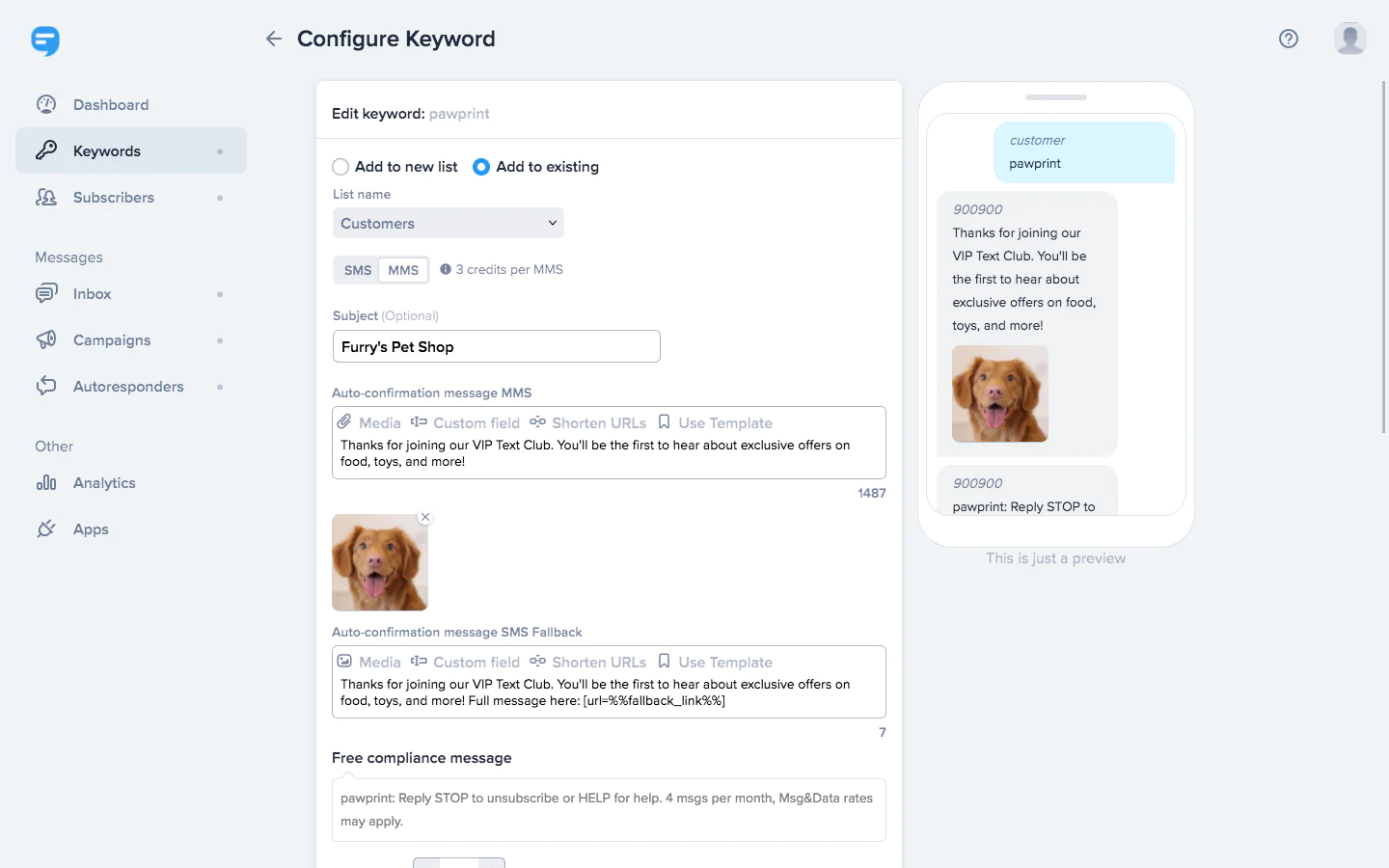
Setting up keywords in SimpleTexting
Essentially, SimpleTexting focuses on doing the core SMS functions reliably: bulk sends, inbox replying, link tracking, and so on, with an emphasis on usability and affordability.
Key Features:
- Mass texting campaigns: Send out bulk SMS or MMS to your list(s). MMS allows you to include images or even short videos in texts (which can boost engagement if used smartly).
- 2-way messaging & Inbox: Every account gets phone numbers (or short codes) that you use to send texts. Any replies from contacts come into a dashboard where you can read and respond, like checking text messages on a phone but for all subscribers. This is good for customer service or engaging folks who respond to campaigns.
- Keywords for opt-in/out: You can set up multiple keywords (e.g., text “SALE” to join the promo list, “NEWS” for updates, etc.). When people text those keywords, SimpleTexting can auto-reply with a confirmation and add them to the respective list. This is a bread-and-butter SMS marketing feature and SimpleTexting makes it easy to manage.
- Autoresponders and triggers: While not as advanced as workflow builders, you can configure simple automated messages—for example, instantly send a coupon code when someone joins, or a follow-up text a day after they join. You can’t create huge branching sequences, but you can cover the immediate responses and basic scheduled follow-ups.
- Contact management: Upload contacts (with proper consent of course). Store basic info like name, email, etc., and use those in messages (merge tags for personalization like “Hi [Name]”). You can create segments manually or via some simple criteria (like everyone who texted a certain keyword, or everyone on List A but not List B).
- Link tracking & analytics: If you include links, SimpleTexting can automatically shorten them and track clicks, giving you simple metrics on how many clicked. They also show delivery rates, unsubscribes, etc., so you have an idea of campaign performance.
- Apps and integrations: They offer an easy-to-use web app, and also mobile apps so you can manage texts on the go. Integration-wise, beyond Zapier, they have direct integrations with some popular apps like Mailchimp, HubSpot, etc., primarily to sync contacts.
- Compliance tools: They provide help with compliance messaging—e.g., recommended language for initial opt-in confirmation texts, and an automatic “Text STOP to unsubscribe” footer (which is required) that you can include. They keep up with carrier rules (like throughput limits and toll-free verification processes) so small users don’t have to figure that out.
- Pricing simplicity: SimpleTexting typically has plans that allot you a certain number of credits per month (1 SMS = 1 credit, 1 MMS = 3 credits, roughly) and you pay based on that allotment. Plans start at a low number of credits with low cost, making it accessible. There are no onboarding fees or minimum contract commitments at the low end—you can pay monthly and cancel anytime. This is appealing to those who can’t commit to high monthly spends just for texting.
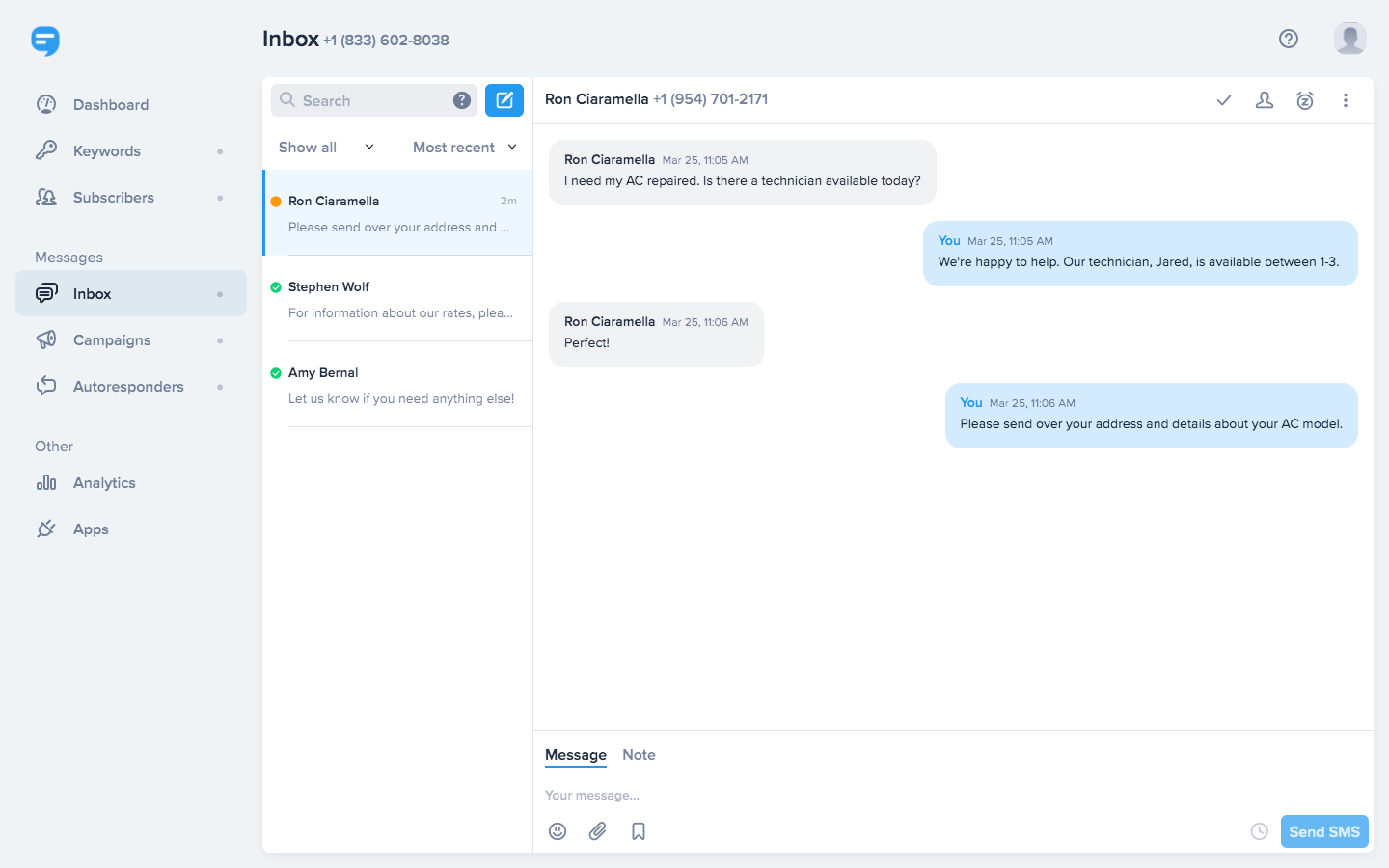
SimpleTexting’s Inbox
Strengths and weaknesses
The major strength of SimpleTexting is right in the name: simplicity. It’s extremely easy to use, even for someone totally new to SMS marketing. Within minutes you can upload a list or get people joining via a keyword, and blast out a text. This makes it great for organizations that might not have dedicated marketing ops teams—think restaurants sending weekly specials, churches sending congregation alerts, or indie ecommerce brands doing occasional promos.

MMS creation in SimpleTexting
The cost is another strength. It’s one of the more affordable solutions, especially when you compare to enterprise platforms. You’re not paying for AI, fancy analytics, or a personal account manager—but you might not need those.
Also, SimpleTexting has a reputation for good customer support (despite being low cost, they have live chat and responsive support to help customers with any issues or questions). It’s also quite reliable; being focused solely on SMS means they’ve optimized deliverability and compliance in that realm. If your needs are basic, you won’t feel like you’re wrestling with a tool that’s too big for you.
However, the weaknesses become apparent as your needs grow. There’s limited automation—you can’t design complex customer journeys or condition-based triggers beyond the basics. For example, you can’t automatically target someone who clicked a link but didn’t purchase with a follow-up text two days later unless you rig up something externally and push the data in. There’s no built-in integration with ecommerce to do advanced stuff like Attentive can. The segmentation is rudimentary, so running highly targeted campaigns might be a manual effort.
Another weakness: no email or multi-channel integration in the platform. It’s SMS-only (with a sprinkle of email capture maybe via a web form, but not for email campaigns). So you’ll likely pair it with an email service, and those two won’t talk to each other unless you integrate via Zapier or such. In contrast, Attentive or others have at least both channels or more built-in.
Also, analytics depth is low—you get clicks and replies, but you won’t easily get revenue attribution unless you manually track coupon usage or use Google Analytics/UTMs to see how SMS traffic converts. A bigger platform might directly tie into sales data and show ROI per text send. With SimpleTexting, you might have to do a bit more legwork to connect those dots.
For some, another limitation is brand perception; using a very basic SMS might mean relying on long phone numbers or shared short codes (though nowadays shared short codes are phased out so you’d have a dedicated number but likely a toll-free or local number, which is fine but less fancy than maybe having a short code—though short codes are pricey anyway). Attentive might provision vanity short codes or multiple numbers to optimize throughput—SimpleTexting by default might throttle large sends on one number, making huge blasts slower (though they do offer high-volume solutions if you ask).

In essence, SimpleTexting is great for simple use-cases but you trade off the advanced marketing capabilities that tools like Attentive offer. For many small operations, that trade-off is acceptable because they wouldn’t use those advanced features anyway, or they can’t afford them. For a sophisticated marketing team, SimpleTexting would feel limiting very quickly.
Compared to Attentive
If Attentive is the high-end solution full of features, SimpleTexting is the pared-down alternative that might actually be better suited for a small outfit.
If you are a small business or organization and Attentive’s salespeople don’t even give you the time of day (Attentive usually targets bigger fish with bigger budgets), SimpleTexting is clearly the more viable choice. Attentive might have minimum monthly spends that are more than a small biz’s entire marketing budget. SimpleTexting has plans that even a local shop can afford. So one big factor is scale and budget.
In terms of features, Attentive offers advanced segmentation using customer data, automated workflows triggered by e-commerce events, AI-driven optimization, and an integrated email channel. SimpleTexting offers none of that out of the box. So if you used Attentive and got used to those features, moving to SimpleTexting would feel like a downgrade in capability. However, maybe you never fully used them, or you found them too complicated or not worth the cost.
One thing Attentive touts is its managed approach—they often provide strategic guidance, and of course, they have those concierge services for two-way if needed. With SimpleTexting, strategy is on you. The platform won’t tell you “here’s the best time to send” or “here’s a suggested campaign based on your data”—Attentive might have some of those insights from experience with large retail clients (and their reps might guide you).
Deliverability & compliance: Attentive likely has strong relationships and processes to maximize throughput and deliverability (given their scale, they can get short codes, etc., and navigate carrier rules quickly). SimpleTexting, while reliable, might not send as fast if you have tens of thousands of messages (they often use toll-free numbers which have throughput limits, though there are workarounds like using multiple numbers).
For an SMB, that’s rarely an issue (sending 5,000 texts might take a few minutes, which is fine). Attentive will make sure 5,000 texts go out almost instantly by using high-speed routes. That matters if you’re doing time-sensitive blasts (e.g., a flash sale that ends in one hour, you want all messages out quickly). But again, scale.
Another difference is analytics and integration. Attentive might integrate with your e-commerce platform to directly show how much each text campaign made in sales. With SimpleTexting, you’d have to do more manual tracking.
Finally, customer experience: Attentive’s texts can be quite personalized if you feed data in—“Hey John, that pair of sneakers you looked at is almost sold out!” That’s powerful but requires data and setup. SimpleTexting can personalize by name or a static field but not much beyond what you import (no real-time behavioral triggers without manual input). So the texts might be more generic.
If your marketing strategy doesn’t require that level of personalization (maybe you only do store-wide sales or announcements), then you’re not missing much. But if you want those event-triggered messages (like browse abandon, cart abandon, etc.), SimpleTexting alone won’t do it—you’d need to hook it up with some other system via API or switch to a more advanced platform like Attentive or others.
In summary, SimpleTexting is an alternative to Attentive for those who find Attentive’s complexity or cost unnecessary for their needs. It’s essentially “SMS marketing light.” You lose the fancy features but keep the core ability to text your customers, which for many is the main point.
Compared to Maestra
SimpleTexting vs. Maestra is akin to comparing a toolbox containing only a hammer and nails to an entire construction crew with power tools and an architectural plan. They’re drastically different in scope.
Maestra offers an integrated marketing ecosystem—SMS, email, push, loyalty, site personalization, unified by a real-time data platform and guided by their team. SimpleTexting offers… SMS. Just SMS, and not even with advanced automation or data unification (outside of what you upload).
The only scenario to compare is perhaps a resource-strapped one: say a mid-sized brand is thinking “we can’t afford Maestra or fully commit to that yet, what if we just handle SMS and some basic email ourselves with cheaper tools?” Then SimpleTexting (for SMS) plus maybe Mailchimp for email might be their DIY approach instead of Maestra. That sacrifices a lot of integration and finesse, but saves money.
From Attentive’s perspective (since these are alternatives to Attentive, which is more similar in channel scope to SimpleTexting albeit with more features): If you didn’t want to invest in a platform like Maestra, you’d not drop to SimpleTexting unless you were drastically cutting down strategy. They solve different problems. Maestra solves “how do I maximize LTV with cross-channel data-driven marketing” whereas SimpleTexting solves “how do I send texts to customers.”
So basically, Maestra vs SimpleTexting isn’t a typical either/or for the same requirement. It’s a matter of scale and needs.
So, compared directly:
- Capabilities: Maestra can do everything SimpleTexting does with SMS (send blasts, two-way messaging, segmentation) and do it in a more integrated, automated, and data-rich way. And then do 10x more beyond that with other channels. SimpleTexting cannot even attempt most of Maestra’s capabilities.
- Ease of use: Interestingly, SimpleTexting might actually be easier for a very small scope because it’s minimal. Klaviyo will have a learning curve to use all features. For someone who just wants to quickly send a manual text to 100 customers, SimpleTexting is simpler. Klaviyo’s value is in setting up automated flows which take some thought and config.
- Cost: SimpleTexting you might pay $200 a month or something for moderate usage. Maestra is in the thousands per month. The magnitude difference is huge—but so is the value proposition.
- Integration: Maestra integrates all your data and channels, so SMS can be part of a bigger picture. SimpleTexting on its own is siloed: you might have to manually integrate it with your other systems to keep data consistent. That’s a known limitation; some use cases might not mind (like a local business might not even have other systems to integrate with). But any serious e-com or organization likely wants at least some integration.
In conclusion, if Attentive was too limited and you want much more, you go to Maestra (or Braze, etc.). If Attentive was too much and you want to simplify, you might go to SimpleTexting. They represent two opposite alternative directions one could take from Attentive. We include both because readers of an “Attentive alternatives” piece could be either type: some looking to scale up and integrate (Maestra, Braze, etc.), others looking to cut costs or simplify (SimpleTexting, SlickText, etc.).
What Each Tool Brings to the Table
Here’s how our Attentive alternatives stack up at a glance:
- Omnichannel Powerhouses: Maestra and Braze deliver SMS alongside email, push, and more, giving larger brands a unified platform to engage customers on every channel (Maestra even adds loyalty and personalization into the mix). They’re ideal if you’re looking to go beyond SMS and consolidate your marketing stack for a holistic strategy.
- Email + SMS All-in-One: Klaviyo and Omnisend combine robust email marketing with SMS under one roof. These are perfect for e-commerce teams that want tight integration between their email and text campaigns (with Klaviyo skewing towards advanced data capabilities and Omnisend towards ease and affordability for SMBs).
- Conversational Focus: Emotive stands out by turning SMS into a two-way sales conversation. If your brand benefits from real-time Q&A and personal engagement via text (and you have the resources to manage it), Emotive can drive higher conversion through humanized interactions that Attentive’s automated texts might miss.
- SMS Specialists for E-commerce: Postscript shines for Shopify-based businesses that need a specialized SMS solution deeply embedded in their store’s operations. It’s great for leveraging Shopify data and quick to launch with pre-built flows for cart abandonment and more—an Attentive alternative that feels tailor-made for online store integration.
- No-Frills Texting Solutions: SimpleTexting (and similar platforms like SlickText) offer straightforward mass texting without the complexity. If you’re a small business or organization that found Attentive’s feature set overkill, these tools let you send promotions, alerts, and engage in 1:1 texting without breaking the bank or needing a dedicated tech team.
Each alternative excels in its niche. If we group them relative to Attentive: Maestra and Braze cover the gaps in channels and data integration, Klaviyo and Omnisend address Attentive’s shortcomings in email and cost for SMBs, Emotive targets the need for human touch and conversation, Postscript focuses on Shopify-centric capabilities, and SimpleTexting offers a solution for those who just want simple, budget-friendly texting.
Why Start with Maestra?
With Maestra, you’re not just getting a tool—you’re gaining a full-service partner in growth. Its real-time CDP powers the kind of hyper-personalized marketing flows and loyalty programs that simply aren’t possible with single-purpose platforms. While other alternatives excel in one area or another, Maestra combines the best of these capabilities into one seamless solution. It adapts in real time to each customer’s behavior, integrating every touchpoint—email, SMS, web, push, ads—and evolves alongside your business.
Attentive showed the impact of SMS, but Maestra shows what’s possible when all your channels work in harmony. Whether you’re scaling up or looking to refine a mature strategy, Maestra is built to grow with your brand and eliminate the fragmentation in your tech stack.
The dedicated support (a Customer Success Manager for every client) means you have an expert by your side, ensuring you get maximum value from the platform—from day one, they help design your flows, migrate data, and even craft strategy, acting as an extension of your team.
Choosing the right platform can truly transform your customer experience and drive long-term loyalty and revenue. Don’t settle for “good enough” when you can have the best. If you’re ready to move beyond Attentive’s limits and unlock your full marketing potential, start with Maestra—book a demo today and see how it can revolutionize your business.
